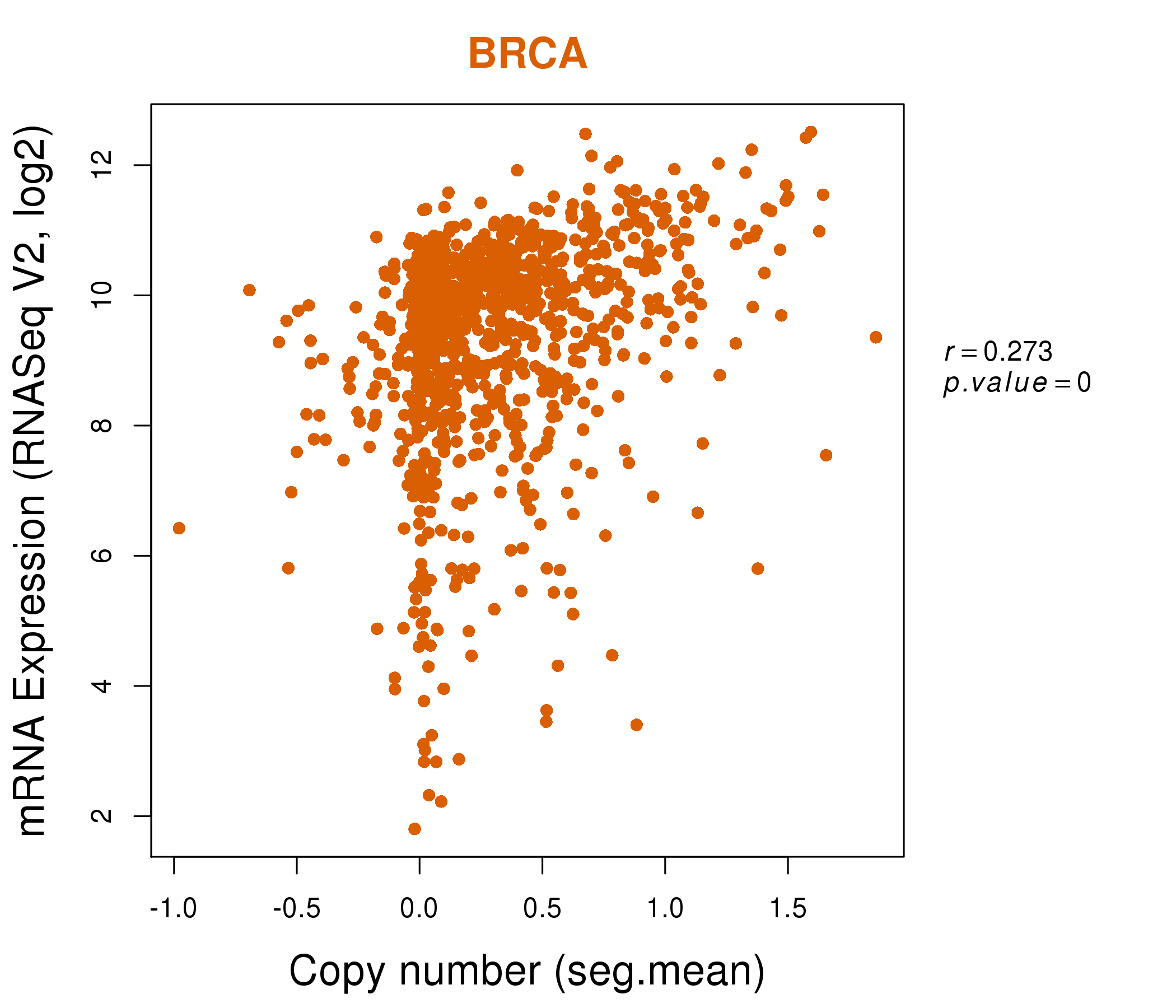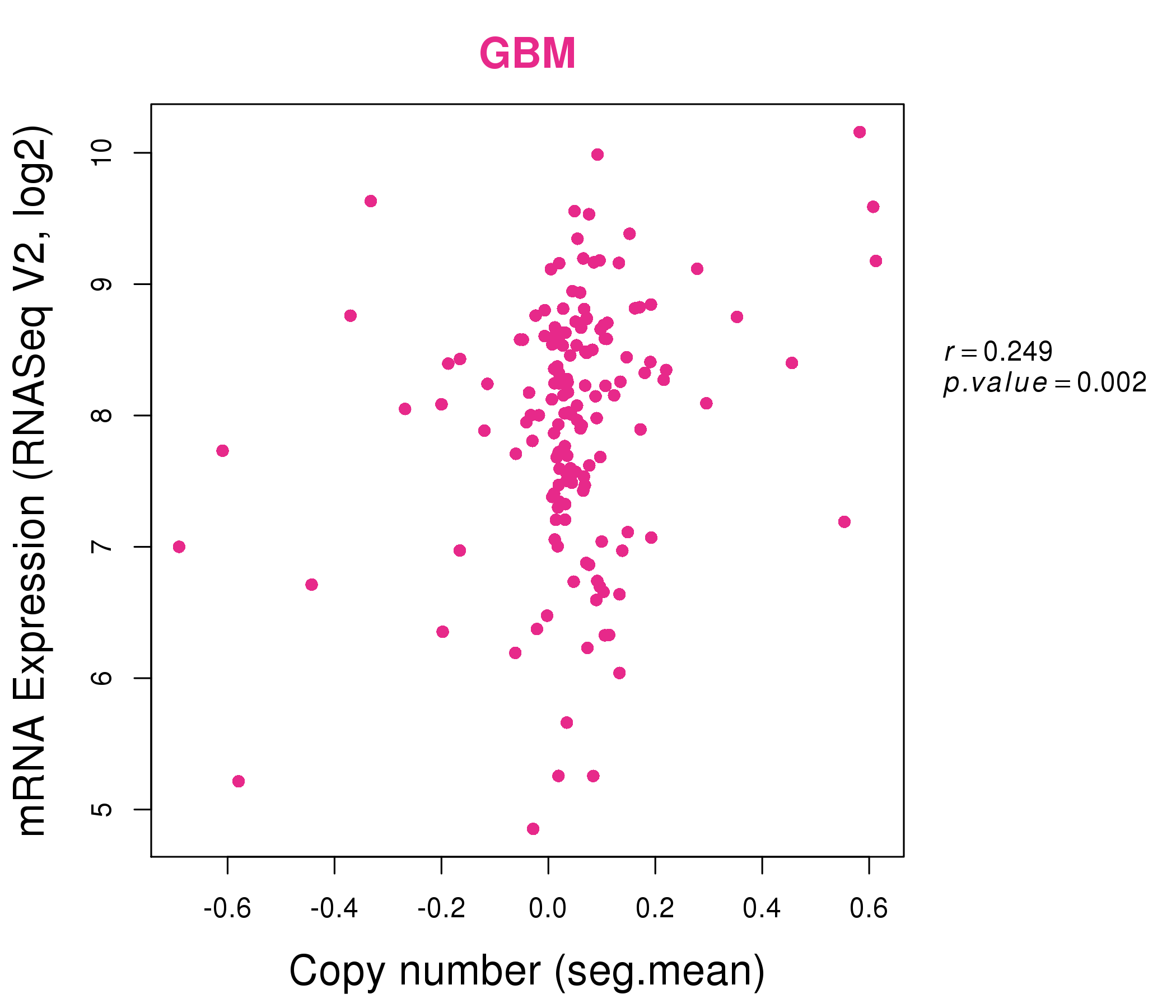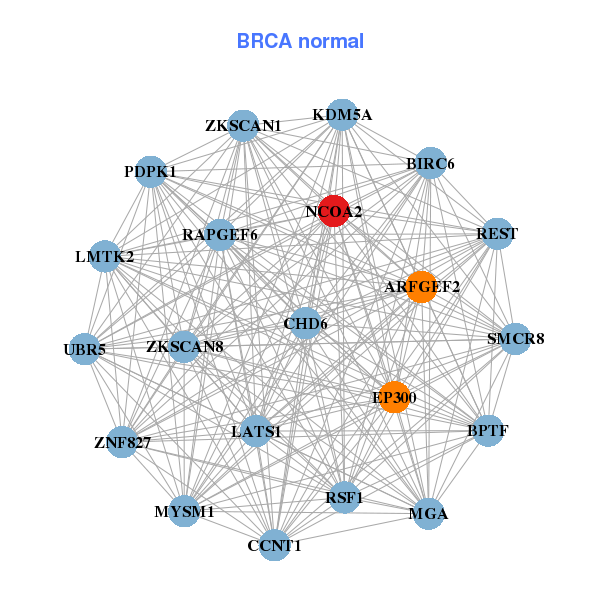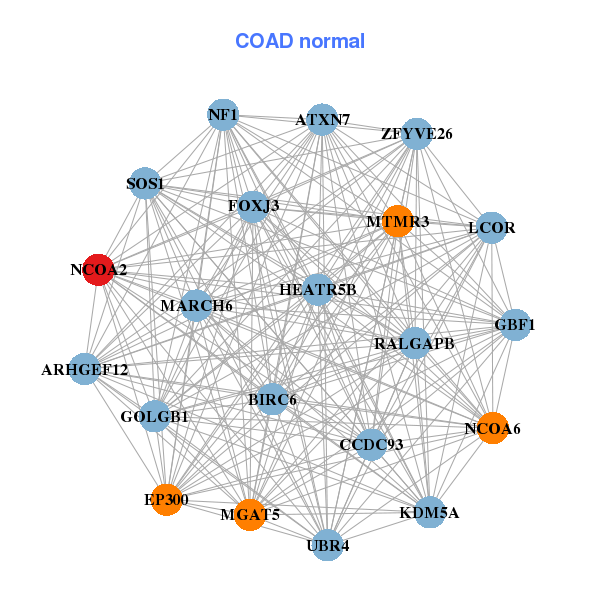|
||||||||||||||||||||||||||||||||||||||||||||||||||||||||||||||||||||||||||||||||||||||||||||||||||||||||||||||||||||||||||||||||||||||||||||||||||||||||||||||||||||||||||||||||||||||||||||||||||||||||||||||||||||||||||||||||||||||||||||||||||||||||||||||||||||||||||||||||||||||||||||||||||||||||||||||||||||||||||||||||||||||||||||||||||||||||||||||||||||||||||||||||||||||||||||||||||||||||||||||||||||||||||||||||||||||||||||||||||||||||||||||||||||||||||||||||||||||||||
| |
| Phenotypic Information (metabolism pathway, cancer, disease, phenome) |
| |
| |
| Gene-Gene Network Information: Co-Expression Network, Interacting Genes & KEGG |
| |
|
| Gene Summary for NCOA2 |
| Basic gene info. | Gene symbol | NCOA2 |
| Gene name | nuclear receptor coactivator 2 | |
| Synonyms | GRIP1|KAT13C|NCoA-2|SRC2|TIF2|bHLHe75 | |
| Cytomap | UCSC genome browser: 8q13.3 | |
| Genomic location | chr8 :71024266-71316020 | |
| Type of gene | protein-coding | |
| RefGenes | NM_006540.2, | |
| Ensembl id | ENSG00000140396 | |
| Description | class E basic helix-loop-helix protein 75glucocorticoid receptor-interacting protein-1hTIF2transcriptional intermediary factor 2 | |
| Modification date | 20141207 | |
| dbXrefs | MIM : 601993 | |
| HGNC : HGNC | ||
| Ensembl : ENSG00000140396 | ||
| HPRD : 09066 | ||
| Vega : OTTHUMG00000164671 | ||
| Protein | UniProt: Q15596 go to UniProt's Cross Reference DB Table | |
| Expression | CleanEX: HS_NCOA2 | |
| BioGPS: 10499 | ||
| Gene Expression Atlas: ENSG00000140396 | ||
| The Human Protein Atlas: ENSG00000140396 | ||
| Pathway | NCI Pathway Interaction Database: NCOA2 | |
| KEGG: NCOA2 | ||
| REACTOME: NCOA2 | ||
| ConsensusPathDB | ||
| Pathway Commons: NCOA2 | ||
| Metabolism | MetaCyc: NCOA2 | |
| HUMANCyc: NCOA2 | ||
| Regulation | Ensembl's Regulation: ENSG00000140396 | |
| miRBase: chr8 :71,024,266-71,316,020 | ||
| TargetScan: NM_006540 | ||
| cisRED: ENSG00000140396 | ||
| Context | iHOP: NCOA2 | |
| cancer metabolism search in PubMed: NCOA2 | ||
| UCL Cancer Institute: NCOA2 | ||
| Assigned class in ccmGDB | A - This gene has a literature evidence and it belongs to cancer gene. | |
| References showing role of NCOA2 in cancer cell metabolism | 1. Qin J, Lee H-J, Wu S-P, Lin S-C, Lanz RB, et al. (2014) Androgen deprivation–induced NCoA2 promotes metastatic and castration-resistant prostate cancer. The Journal of clinical investigation 124: 5013. go to article | |
| Top |
| Phenotypic Information for NCOA2(metabolism pathway, cancer, disease, phenome) |
| Cancer | CGAP: NCOA2 |
| Familial Cancer Database: NCOA2 | |
| * This gene is included in those cancer gene databases. |
|
|
|
|
|
| . | ||||||||||||||||||||||||||||||||||||||||||||||||||||||||||||||||||||||||||||||||||||||||||||||||||||||||||||||||||||||||||||||||||||||||||||||||||||||||||||||||||||||||||||||||||||||||||||||||||||||||||||||||||||||||||||||||||||||||||||||||||||||||||||||||||||||||||||||||||||||||||||||||||||||||||||||||||||||||||||||||||||||||||||||||||||||||||||||||||||||||||||||||||||||||||||||||||||||||||||||||||||||||||||||||||||||||||||||||||||||||||||||||||||||||||||||||||||
Oncogene 1 | Significant driver gene in | |||||||||||||||||||||||||||||||||||||||||||||||||||||||||||||||||||||||||||||||||||||||||||||||||||||||||||||||||||||||||||||||||||||||||||||||||||||||||||||||||||||||||||||||||||||||||||||||||||||||||||||||||||||||||||||||||||||||||||||||||||||||||||||||||||||||||||||||||||||||||||||||||||||||||||||||||||||||||||||||||||||||||||||||||||||||||||||||||||||||||||||||||||||||||||||||||||||||||||||||||||||||||||||||||||||||||||||||||||||||||||||||||||||||||||||||||||||||||
| cf) number; DB name 1 Oncogene; http://nar.oxfordjournals.org/content/35/suppl_1/D721.long, 2 Tumor Suppressor gene; https://bioinfo.uth.edu/TSGene/, 3 Cancer Gene Census; http://www.nature.com/nrc/journal/v4/n3/abs/nrc1299.html, 4 CancerGenes; http://nar.oxfordjournals.org/content/35/suppl_1/D721.long, 5 Network of Cancer Gene; http://ncg.kcl.ac.uk/index.php, 1Therapeutic Vulnerabilities in Cancer; http://cbio.mskcc.org/cancergenomics/statius/ |
| REACTOME_METABOLISM_OF_LIPIDS_AND_LIPOPROTEINS | |
| OMIM | 601993; gene. |
| Orphanet | |
| Disease | KEGG Disease: NCOA2 |
| MedGen: NCOA2 (Human Medical Genetics with Condition) | |
| ClinVar: NCOA2 | |
| Phenotype | MGI: NCOA2 (International Mouse Phenotyping Consortium) |
| PhenomicDB: NCOA2 | |
| Mutations for NCOA2 |
| * Under tables are showing count per each tissue to give us broad intuition about tissue specific mutation patterns.You can go to the detailed page for each mutation database's web site. |
| - Statistics for Tissue and Mutation type | Top |
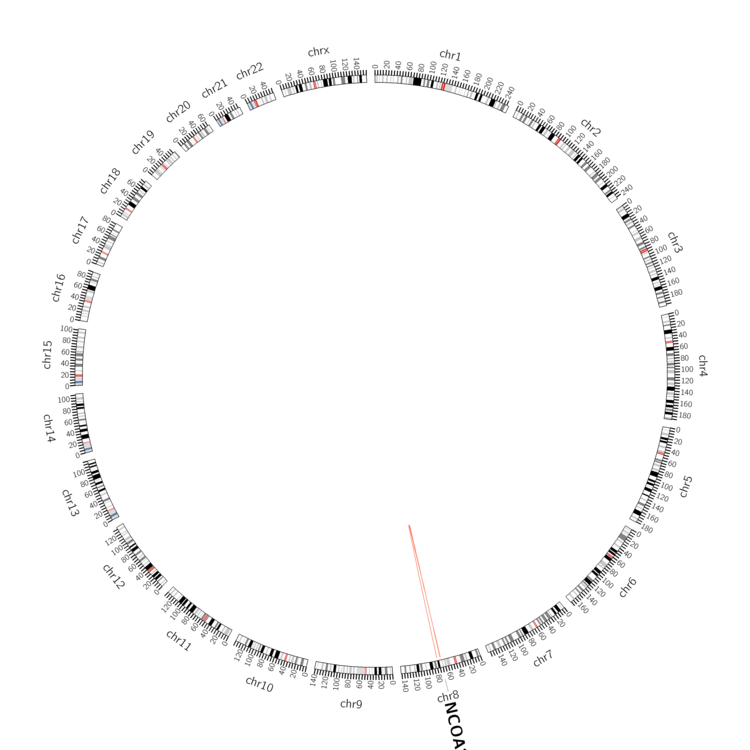 |
| - For Inter-chromosomal Variations |
| There's no inter-chromosomal structural variation. |
| - For Intra-chromosomal Variations |
| * Intra-chromosomal variantions includes 'intrachromosomal amplicon to amplicon', 'intrachromosomal amplicon to non-amplified dna', 'intrachromosomal deletion', 'intrachromosomal fold-back inversion', 'intrachromosomal inversion', 'intrachromosomal tandem duplication', 'Intrachromosomal unknown type', 'intrachromosomal with inverted orientation', 'intrachromosomal with non-inverted orientation'. |
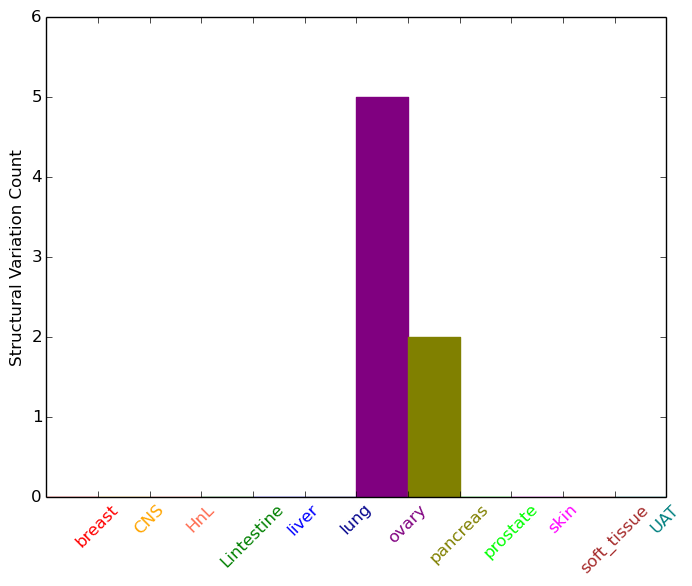 |
| Sample | Symbol_a | Chr_a | Start_a | End_a | Symbol_b | Chr_b | Start_b | End_b |
| ovary | NCOA2 | chr8 | 71077499 | 71077519 | NCOA2 | chr8 | 71061252 | 71061272 |
| ovary | NCOA2 | chr8 | 71156369 | 71156389 | NCOA2 | chr8 | 71152679 | 71152699 |
| ovary | NCOA2 | chr8 | 71267491 | 71267511 | NCOA2 | chr8 | 71268959 | 71268979 |
| ovary | NCOA2 | chr8 | 71281406 | 71281426 | NCOA2 | chr8 | 71295100 | 71295120 |
| pancreas | NCOA2 | chr8 | 71079954 | 71079974 | chr8 | 77478156 | 77478176 | |
| pancreas | NCOA2 | chr8 | 71081030 | 71081050 | NCOA2 | chr8 | 71081315 | 71081335 |
| cf) Tissue number; Tissue name (1;Breast, 2;Central_nervous_system, 3;Haematopoietic_and_lymphoid_tissue, 4;Large_intestine, 5;Liver, 6;Lung, 7;Ovary, 8;Pancreas, 9;Prostate, 10;Skin, 11;Soft_tissue, 12;Upper_aerodigestive_tract) |
| * From mRNA Sanger sequences, Chitars2.0 arranged chimeric transcripts. This table shows NCOA2 related fusion information. |
| ID | Head Gene | Tail Gene | Accession | Gene_a | qStart_a | qEnd_a | Chromosome_a | tStart_a | tEnd_a | Gene_a | qStart_a | qEnd_a | Chromosome_a | tStart_a | tEnd_a |
| EF374064 | KAT6A | 1 | 75 | 8 | 41794774 | 41794848 | NCOA2 | 75 | 476 | 8 | 71053441 | 71057084 | |
| AW979049 | NCOA2 | 90 | 243 | 8 | 71218596 | 71218749 | SLC35B4 | 241 | 456 | 7 | 133984283 | 133986549 | |
| BG260721 | NCOA2 | 1 | 296 | 8 | 71261230 | 71261525 | SLC7A1 | 281 | 418 | 13 | 30083551 | 30083688 | |
| AA829002 | NCOA2 | 4 | 188 | 8 | 71218565 | 71218749 | NCOA2 | 184 | 326 | 8 | 71218447 | 71218589 | |
| BG674032 | NCOA2 | 1 | 155 | 8 | 71172635 | 71172788 | MAP2K3 | 148 | 723 | 17 | 21213574 | 21214148 | |
| AA829004 | NCOA2 | 4 | 188 | 8 | 71218565 | 71218749 | NCOA2 | 184 | 330 | 8 | 71218447 | 71218593 | |
| DA677327 | NCOA2 | 1 | 129 | 8 | 71315935 | 71316063 | KLHL28 | 129 | 595 | 14 | 45414354 | 45415132 | |
| BG222207 | HMGN3 | 7 | 105 | 6 | 79923102 | 79923200 | NCOA2 | 106 | 257 | 8 | 71294826 | 71294977 | |
| BE009179 | NCOA2 | 10 | 380 | 8 | 71110391 | 71110761 | PTPRE | 364 | 443 | 10 | 129789785 | 129789864 | |
| BF379189 | AKAP13 | 1 | 235 | 15 | 85959552 | 85959789 | NCOA2 | 227 | 362 | 8 | 71246232 | 71246367 | |
| BE149299 | THSD7B | 160 | 180 | 2 | 137875796 | 137875816 | NCOA2 | 168 | 409 | 8 | 71218444 | 71218685 | |
| BF811949 | NCOA2 | 23 | 315 | 8 | 71092000 | 71092293 | NCOA2 | 310 | 464 | 8 | 71091671 | 71091825 | |
| BF088409 | NCOA2 | 3 | 142 | 8 | 71246435 | 71246573 | RHOB | 141 | 436 | 2 | 20648632 | 20648927 | |
| AL706656 | NCOA2 | 23 | 43 | 8 | 71290981 | 71291001 | CAPZB | 26 | 826 | 1 | 19672171 | 19672964 | |
| Top |
| Mutation type/ Tissue ID | brca | cns | cerv | endome | haematopo | kidn | Lintest | liver | lung | ns | ovary | pancre | prost | skin | stoma | thyro | urina | |||
| Total # sample | 4 | 1 | 1 | 2 | 2 | 1 | 1 | |||||||||||||
| GAIN (# sample) | 3 | 1 | 1 | 2 | 1 | 1 | 1 | |||||||||||||
| LOSS (# sample) | 1 | 1 |
| cf) Tissue ID; Tissue type (1; Breast, 2; Central_nervous_system, 3; Cervix, 4; Endometrium, 5; Haematopoietic_and_lymphoid_tissue, 6; Kidney, 7; Large_intestine, 8; Liver, 9; Lung, 10; NS, 11; Ovary, 12; Pancreas, 13; Prostate, 14; Skin, 15; Stomach, 16; Thyroid, 17; Urinary_tract) |
| Top |
|
 |
| Top |
| Stat. for Non-Synonymous SNVs (# total SNVs=134) | (# total SNVs=34) |
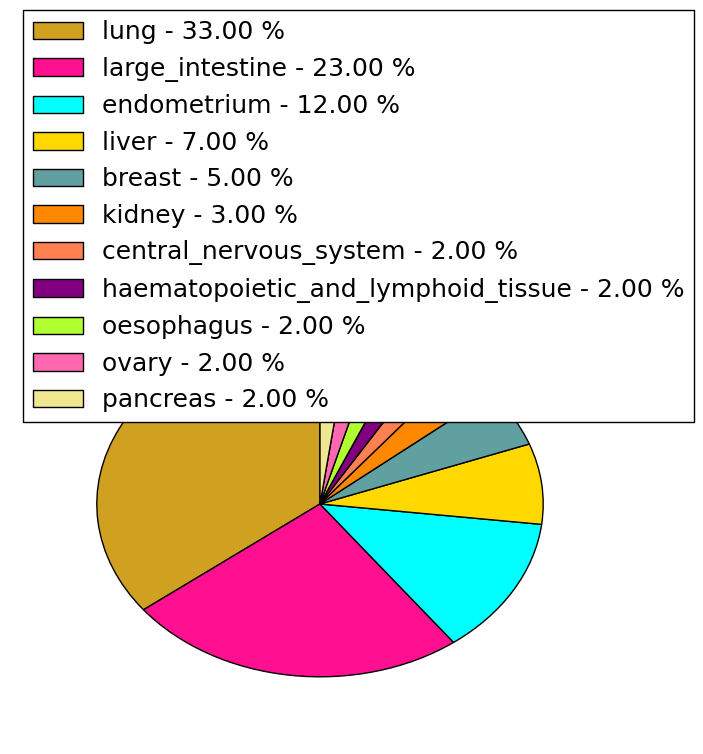 | 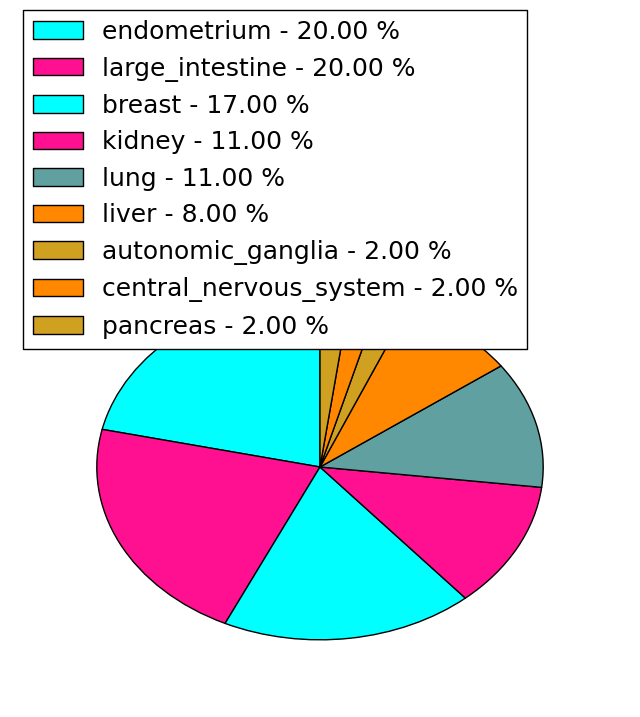 |
(# total SNVs=1) | (# total SNVs=1) |
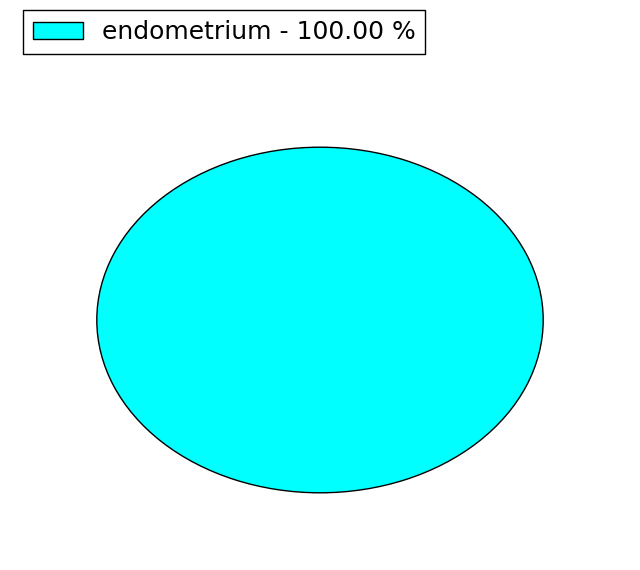 | 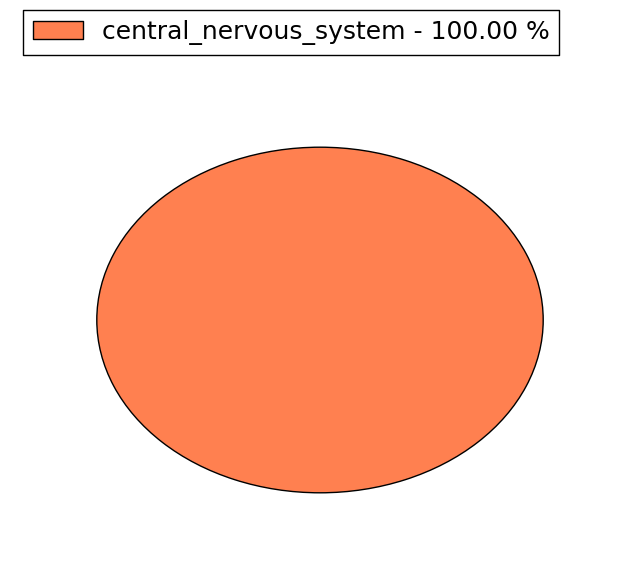 |
| Top |
| * When you move the cursor on each content, you can see more deailed mutation information on the Tooltip. Those are primary_site,primary_histology,mutation(aa),pubmedID. |
| GRCh37 position | Mutation(aa) | Unique sampleID count |
| chr8:71074996-71074996 | p.A309V | 3 |
| chr8:71078928-71078928 | p.R201R | 3 |
| chr8:71068993-71068993 | p.A536V | 2 |
| chr8:71071833-71071833 | p.G344V | 2 |
| chr8:71050502-71050502 | p.Q1032E | 2 |
| chr8:71069190-71069190 | p.P470P | 2 |
| chr8:71078966-71078966 | p.E189* | 2 |
| chr8:71087031-71087031 | p.G108D | 2 |
| chr8:71068807-71068807 | p.G598V | 2 |
| chr8:71039182-71039182 | p.R1261Q | 2 |
| Top |
|
 |
| Point Mutation/ Tissue ID | 1 | 2 | 3 | 4 | 5 | 6 | 7 | 8 | 9 | 10 | 11 | 12 | 13 | 14 | 15 | 16 | 17 | 18 | 19 | 20 |
| # sample | 3 | 4 | 1 | 29 | 2 | 5 | 4 | 1 | 13 | 9 | 2 | 1 | 13 | 22 | 14 | |||||
| # mutation | 3 | 4 | 1 | 28 | 2 | 5 | 4 | 1 | 16 | 9 | 2 | 1 | 16 | 30 | 20 | |||||
| nonsynonymous SNV | 3 | 2 | 23 | 1 | 3 | 2 | 15 | 8 | 2 | 1 | 13 | 22 | 13 | |||||||
| synonymous SNV | 2 | 1 | 5 | 1 | 2 | 2 | 1 | 1 | 1 | 3 | 8 | 7 |
| cf) Tissue ID; Tissue type (1; BLCA[Bladder Urothelial Carcinoma], 2; BRCA[Breast invasive carcinoma], 3; CESC[Cervical squamous cell carcinoma and endocervical adenocarcinoma], 4; COAD[Colon adenocarcinoma], 5; GBM[Glioblastoma multiforme], 6; Glioma Low Grade, 7; HNSC[Head and Neck squamous cell carcinoma], 8; KICH[Kidney Chromophobe], 9; KIRC[Kidney renal clear cell carcinoma], 10; KIRP[Kidney renal papillary cell carcinoma], 11; LAML[Acute Myeloid Leukemia], 12; LUAD[Lung adenocarcinoma], 13; LUSC[Lung squamous cell carcinoma], 14; OV[Ovarian serous cystadenocarcinoma ], 15; PAAD[Pancreatic adenocarcinoma], 16; PRAD[Prostate adenocarcinoma], 17; SKCM[Skin Cutaneous Melanoma], 18:STAD[Stomach adenocarcinoma], 19:THCA[Thyroid carcinoma], 20:UCEC[Uterine Corpus Endometrial Carcinoma]) |
| Top |
| * We represented just top 10 SNVs. When you move the cursor on each content, you can see more deailed mutation information on the Tooltip. Those are primary_site, primary_histology, mutation(aa), pubmedID. |
| Genomic Position | Mutation(aa) | Unique sampleID count |
| chr8:71074996 | p.A309V | 3 |
| chr8:71078928 | p.G545W | 2 |
| chr8:71069190 | p.P384L | 2 |
| chr8:71068967 | p.L1206P | 2 |
| chr8:71039179 | p.R1329L | 2 |
| chr8:71037031 | p.P470P | 2 |
| chr8:71039182 | p.R201R | 2 |
| chr8:71044133 | p.R1088P | 2 |
| chr8:71069449 | p.T1262N | 2 |
| chr8:71040732 | p.R1261Q | 2 |
| * Copy number data were extracted from TCGA using R package TCGA-Assembler. The URLs of all public data files on TCGA DCC data server were gathered on Jan-05-2015. Function ProcessCNAData in TCGA-Assembler package was used to obtain gene-level copy number value which is calculated as the average copy number of the genomic region of a gene. |
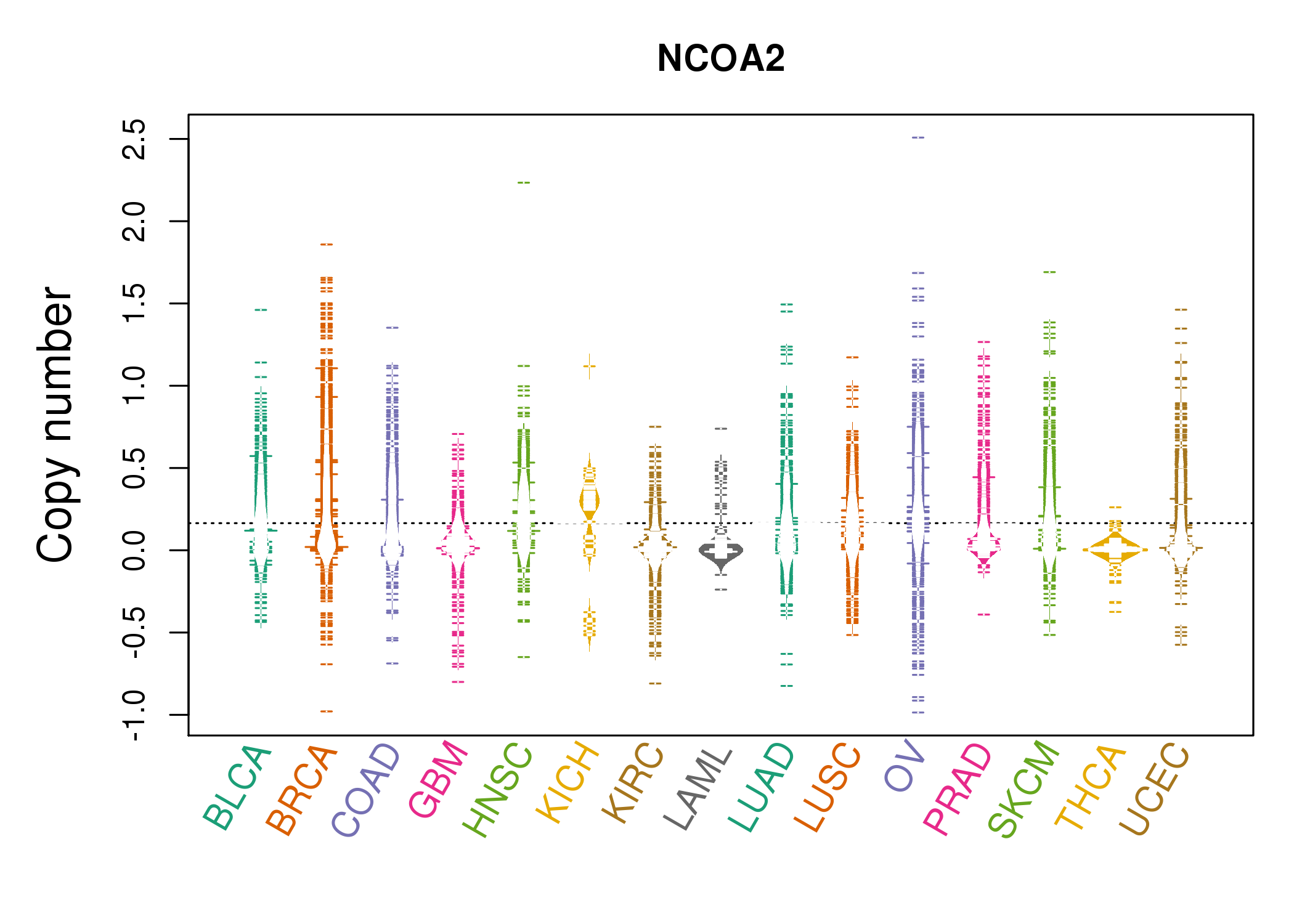 |
| cf) Tissue ID[Tissue type]: BLCA[Bladder Urothelial Carcinoma], BRCA[Breast invasive carcinoma], CESC[Cervical squamous cell carcinoma and endocervical adenocarcinoma], COAD[Colon adenocarcinoma], GBM[Glioblastoma multiforme], Glioma Low Grade, HNSC[Head and Neck squamous cell carcinoma], KICH[Kidney Chromophobe], KIRC[Kidney renal clear cell carcinoma], KIRP[Kidney renal papillary cell carcinoma], LAML[Acute Myeloid Leukemia], LUAD[Lung adenocarcinoma], LUSC[Lung squamous cell carcinoma], OV[Ovarian serous cystadenocarcinoma ], PAAD[Pancreatic adenocarcinoma], PRAD[Prostate adenocarcinoma], SKCM[Skin Cutaneous Melanoma], STAD[Stomach adenocarcinoma], THCA[Thyroid carcinoma], UCEC[Uterine Corpus Endometrial Carcinoma] |
| Top |
| Gene Expression for NCOA2 |
| * CCLE gene expression data were extracted from CCLE_Expression_Entrez_2012-10-18.res: Gene-centric RMA-normalized mRNA expression data. |
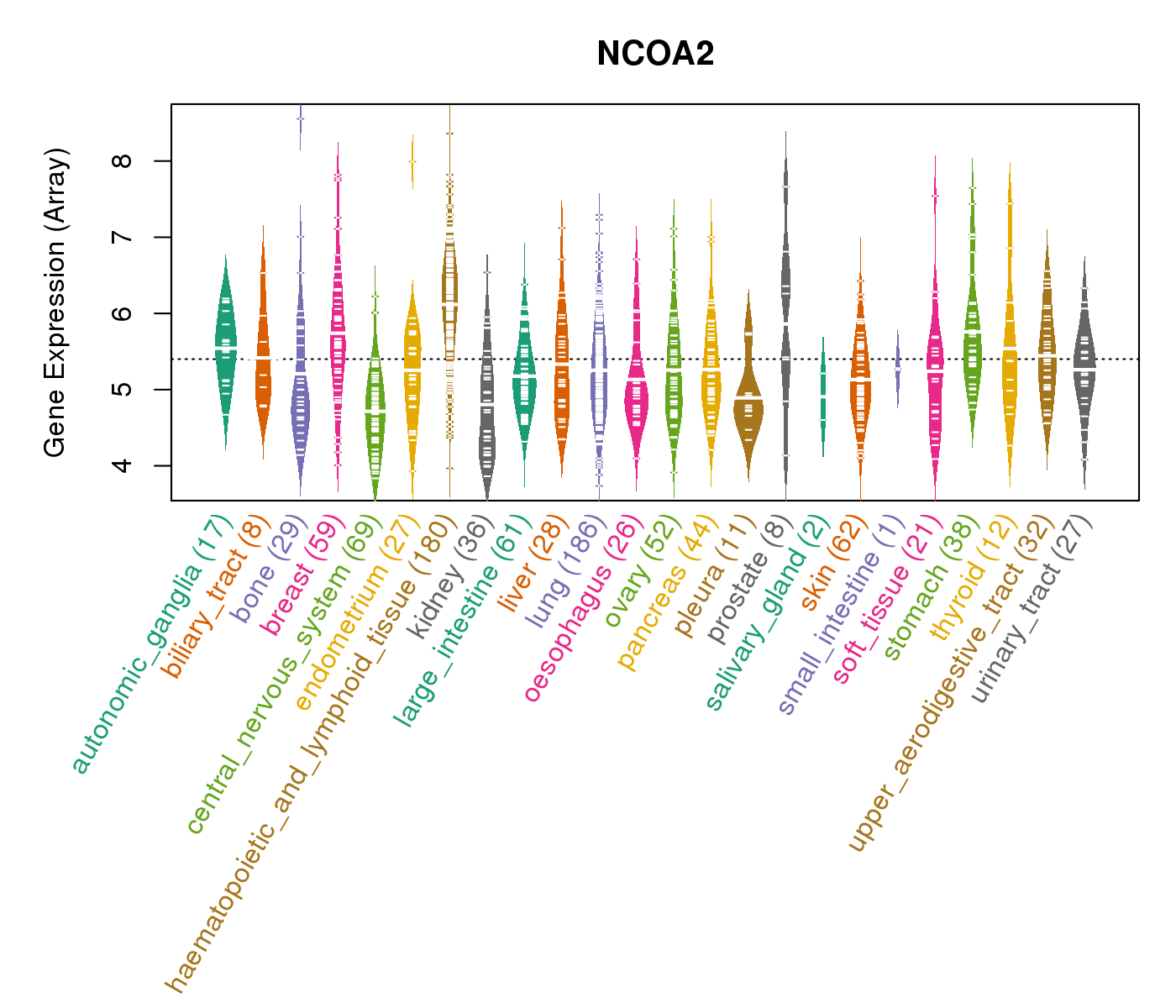 |
| * Normalized gene expression data of RNASeqV2 was extracted from TCGA using R package TCGA-Assembler. The URLs of all public data files on TCGA DCC data server were gathered at Jan-05-2015. Only eight cancer types have enough normal control samples for differential expression analysis. (t test, adjusted p<0.05 (using Benjamini-Hochberg FDR)) |
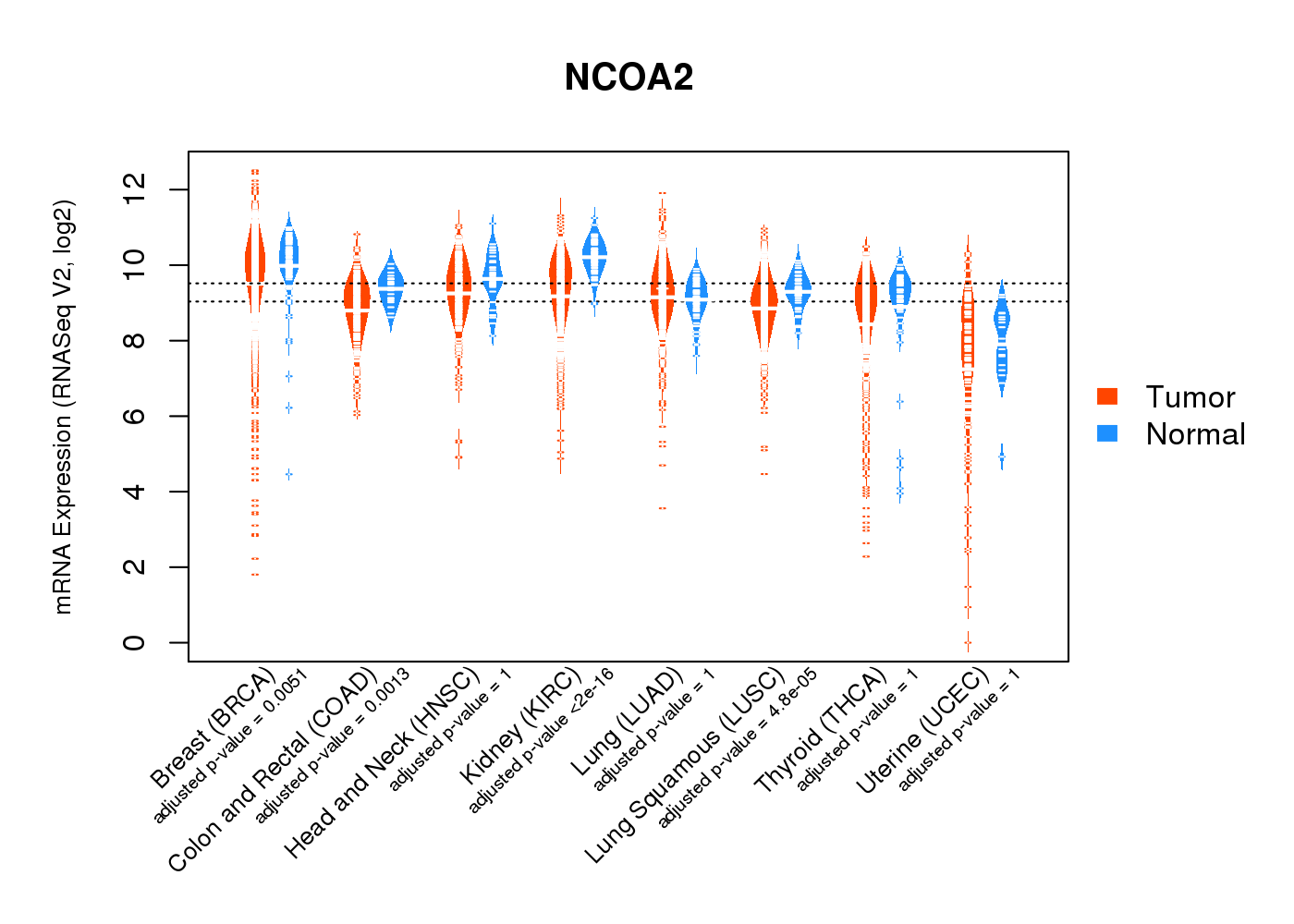 |
| Top |
| * This plots show the correlation between CNV and gene expression. |
: Open all plots for all cancer types
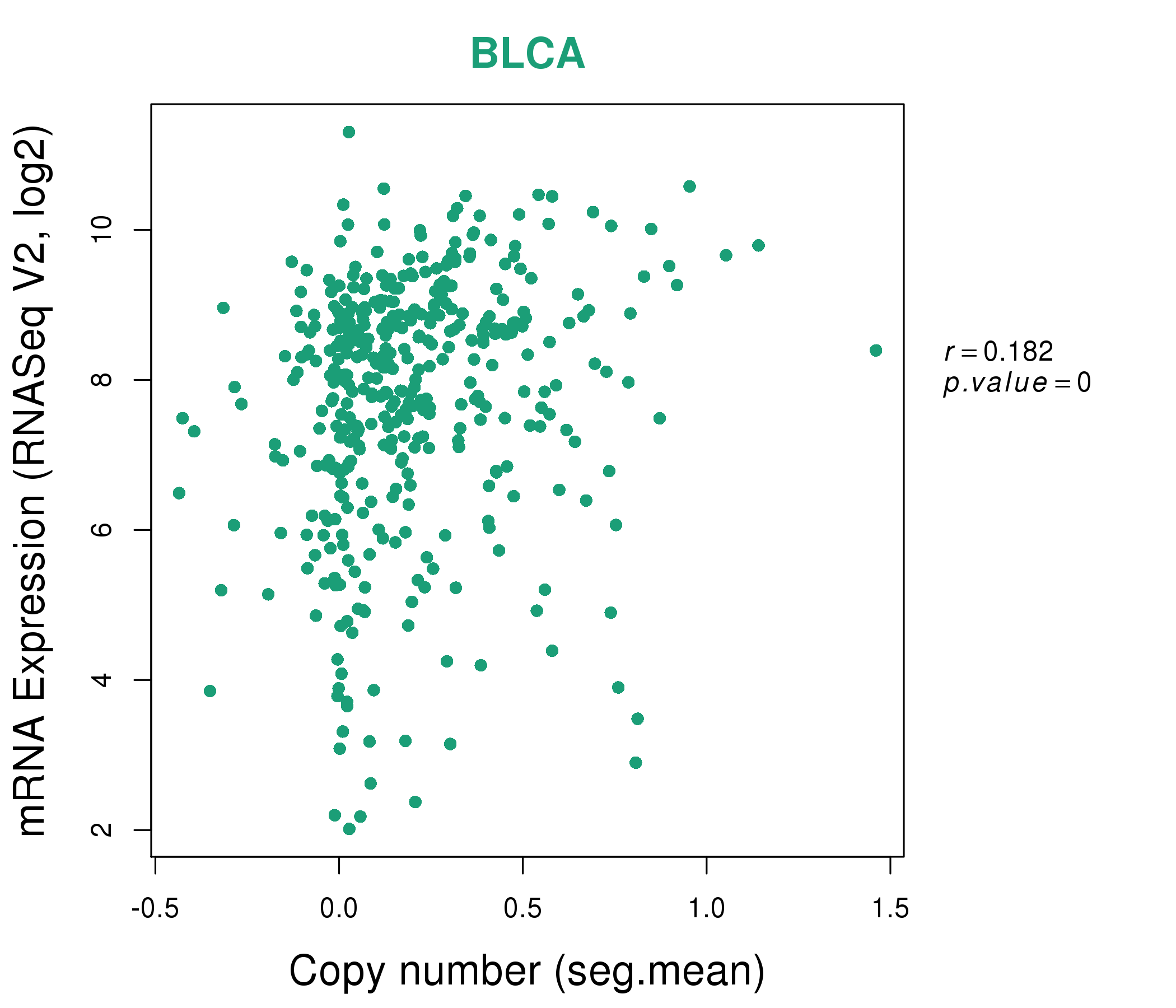 |
|
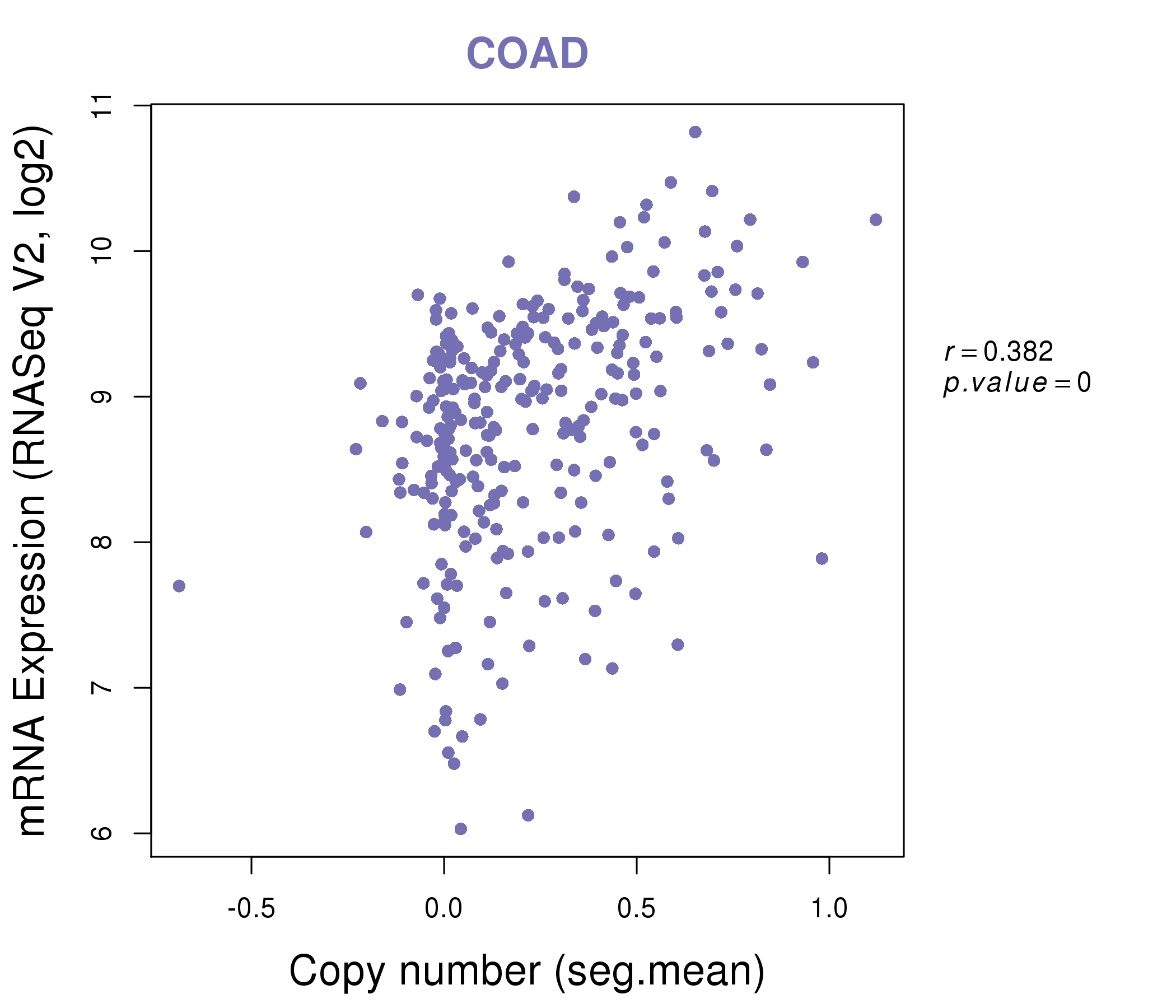 |
|
| Top |
| Gene-Gene Network Information |
| * Co-Expression network figures were drawn using R package igraph. Only the top 20 genes with the highest correlations were shown. Red circle: input gene, orange circle: cell metabolism gene, sky circle: other gene |
: Open all plots for all cancer types
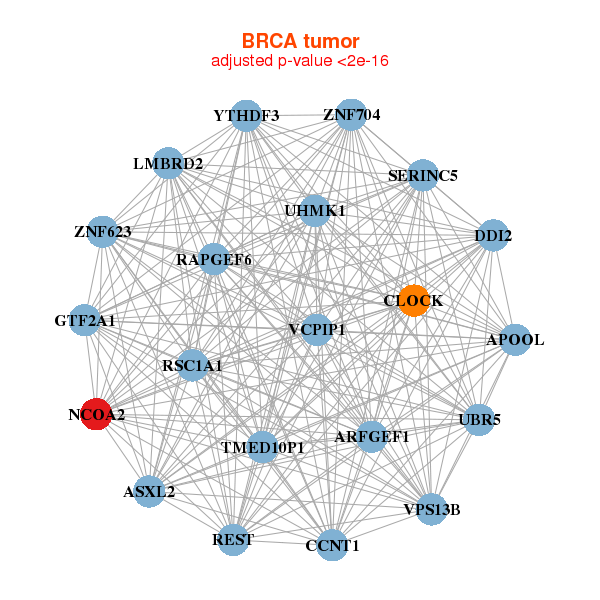 |
| ||||
| APOOL,ARFGEF1,ASXL2,CCNT1,CLOCK,DDI2,GTF2A1, LMBRD2,NCOA2,RAPGEF6,REST,RSC1A1,SERINC5,TMED10P1, UBR5,UHMK1,VCPIP1,VPS13B,YTHDF3,ZNF623,ZNF704 | ARFGEF2,BIRC6,BPTF,CCNT1,CHD6,EP300,KDM5A, LATS1,LMTK2,MGA,MYSM1,NCOA2,PDPK1,RAPGEF6, REST,RSF1,SMCR8,UBR5,ZKSCAN1,ZKSCAN8,ZNF827 | ||||
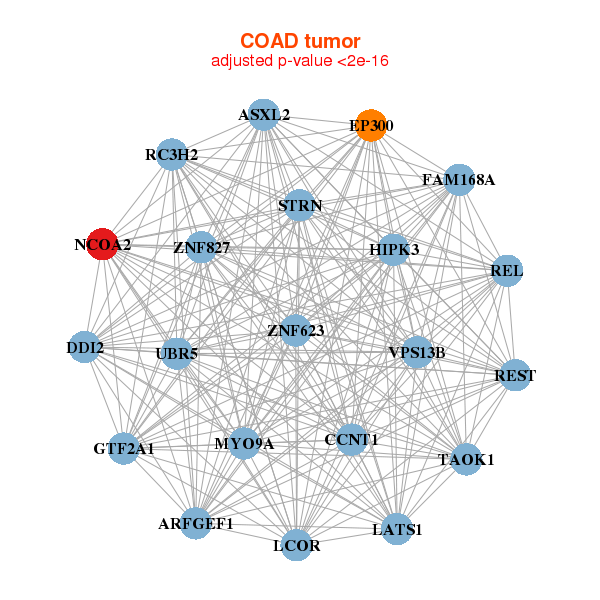 |
| ||||
| ARFGEF1,ASXL2,CCNT1,DDI2,EP300,FAM168A,GTF2A1, HIPK3,LATS1,LCOR,MYO9A,NCOA2,RC3H2,REL, REST,STRN,TAOK1,UBR5,VPS13B,ZNF623,ZNF827 | ARHGEF12,ATXN7,BIRC6,CCDC93,EP300,FOXJ3,GBF1, GOLGB1,HEATR5B,KDM5A,LCOR,MARCH6,MGAT5,MTMR3, NCOA2,NCOA6,NF1,RALGAPB,SOS1,UBR4,ZFYVE26 |
| * Co-Expression network figures were drawn using R package igraph. Only the top 20 genes with the highest correlations were shown. Red circle: input gene, orange circle: cell metabolism gene, sky circle: other gene |
: Open all plots for all cancer types
| Top |
: Open all interacting genes' information including KEGG pathway for all interacting genes from DAVID
| Top |
| Pharmacological Information for NCOA2 |
| DB Category | DB Name | DB's ID and Url link |
| Chemistry | ChEMBL | CHEMBL2095163; -. |
| Organism-specific databases | PharmGKB | PA31471; -. |
| Organism-specific databases | CTD | 10499; -. |
| * Gene Centered Interaction Network. |
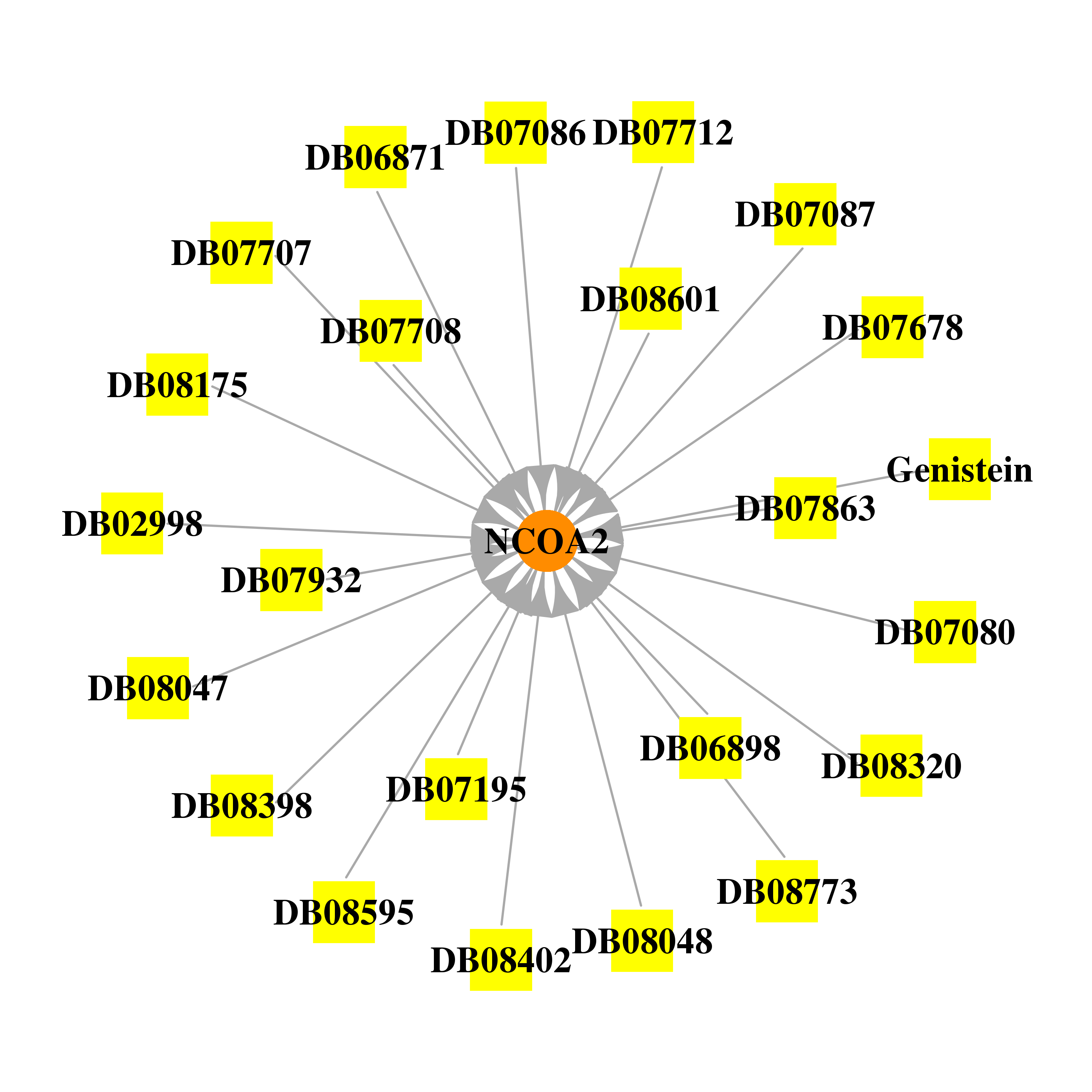 |
| * Drug Centered Interaction Network. |
| DrugBank ID | Target Name | Drug Groups | Generic Name | Drug Centered Network | Drug Structure |
| DB01645 | nuclear receptor coactivator 2 | experimental | Genistein |  | 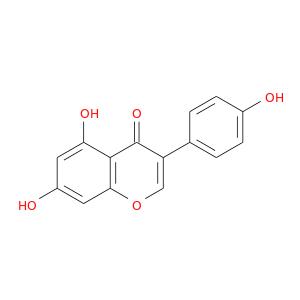 |
| DB02998 | nuclear receptor coactivator 2 | experimental | Methyltrienolone | 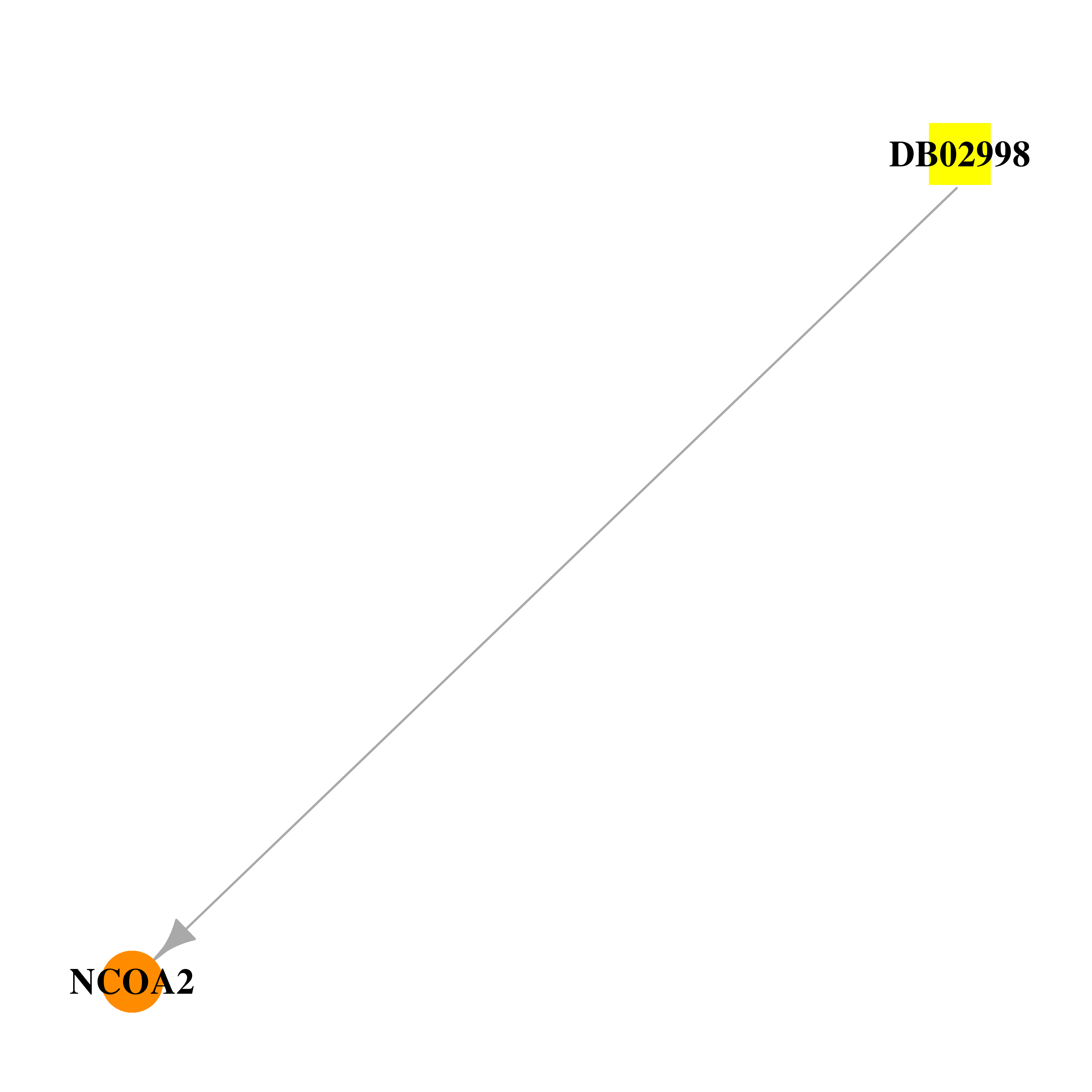 | 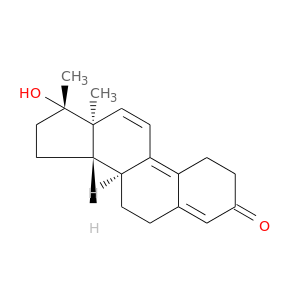 |
| DB06871 | nuclear receptor coactivator 2 | experimental | 17-METHYL-17-ALPHA-DIHYDROEQUILENIN |  | 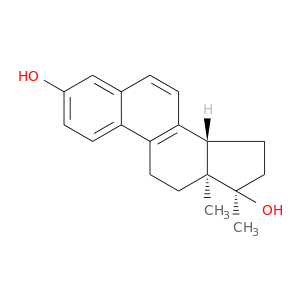 |
| DB06898 | nuclear receptor coactivator 2 | experimental | 4-(2-amino-1-methyl-1H-imidazo[4,5-b]pyridin-6-yl)phenol | 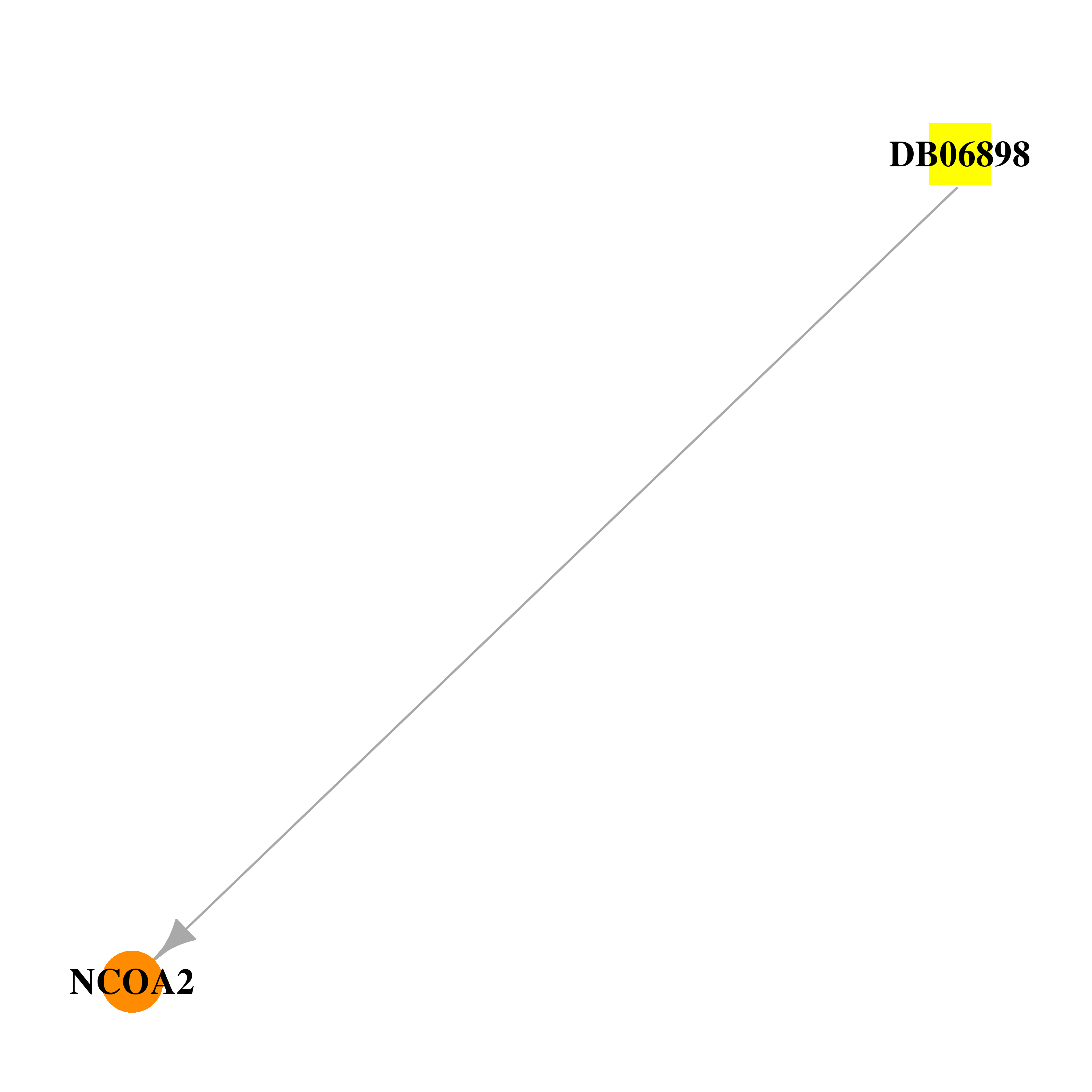 | 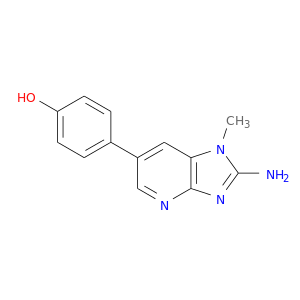 |
| DB07080 | nuclear receptor coactivator 2 | experimental | N-(2,2,2-TRIFLUOROETHYL)-N-{4-[2,2,2-TRIFLUORO-1-HYDROXY-1-(TRIFLUOROMETHYL)ETHYL]PHENYL}BENZENESULFONAMIDE | 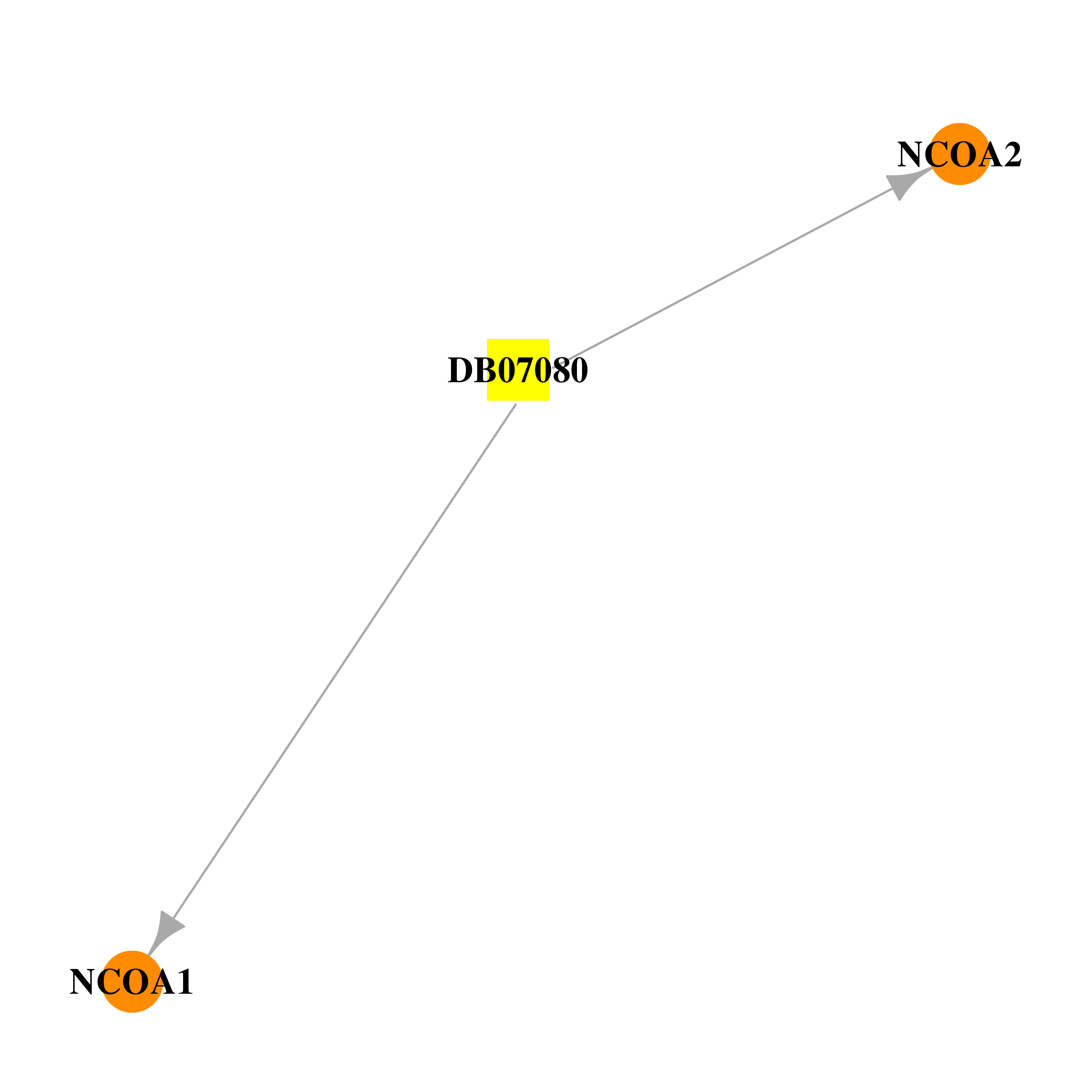 | 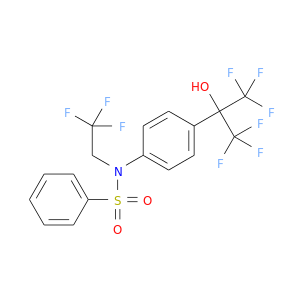 |
| DB07086 | nuclear receptor coactivator 2 | experimental | 4-[(1S,2S,5S)-5-(HYDROXYMETHYL)-8-METHYL-3-OXABICYCLO[3.3.1]NON-7-EN-2-YL]PHENOL |  | 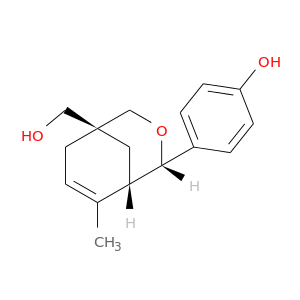 |
| DB07087 | nuclear receptor coactivator 2 | experimental | 4-[(1S,2S,5S,9R)-5-(HYDROXYMETHYL)-8,9-DIMETHYL-3-OXABICYCLO[3.3.1]NON-7-EN-2-YL]PHENOL | 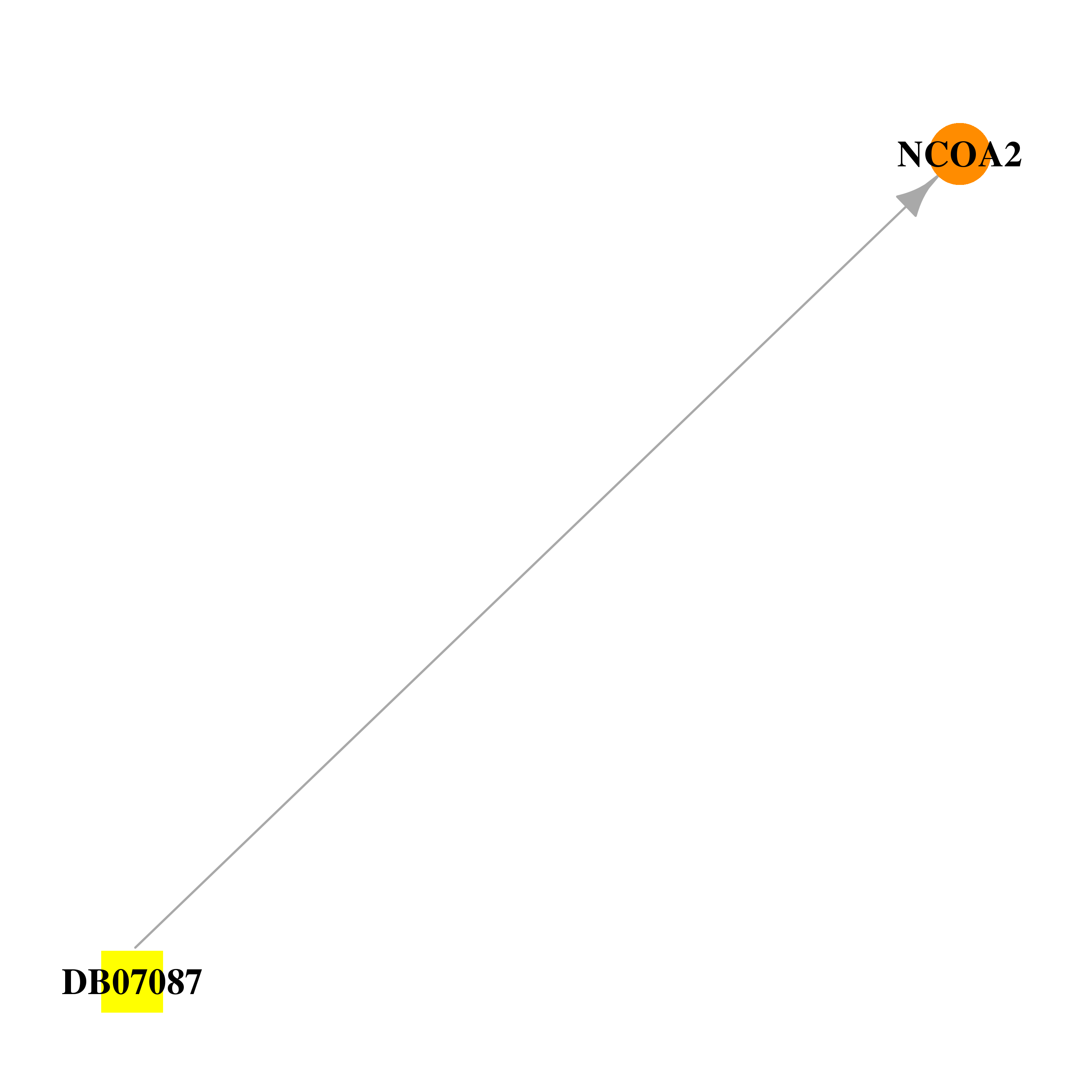 | 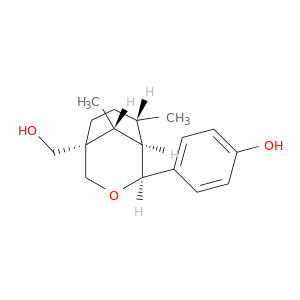 |
| DB07195 | nuclear receptor coactivator 2 | experimental | 4-[(1S,2S,5S)-5-(HYDROXYMETHYL)-6,8,9-TRIMETHYL-3-OXABICYCLO[3.3.1]NON-7-EN-2-YL]PHENOL |  | 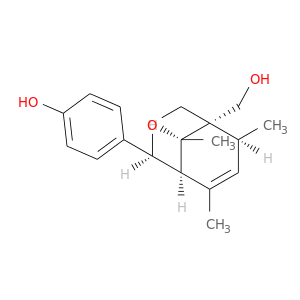 |
| DB07678 | nuclear receptor coactivator 2 | experimental | (9ALPHA,13BETA,17BETA)-2-[(1Z)-BUT-1-EN-1-YL]ESTRA-1,3,5(10)-TRIENE-3,17-DIOL | 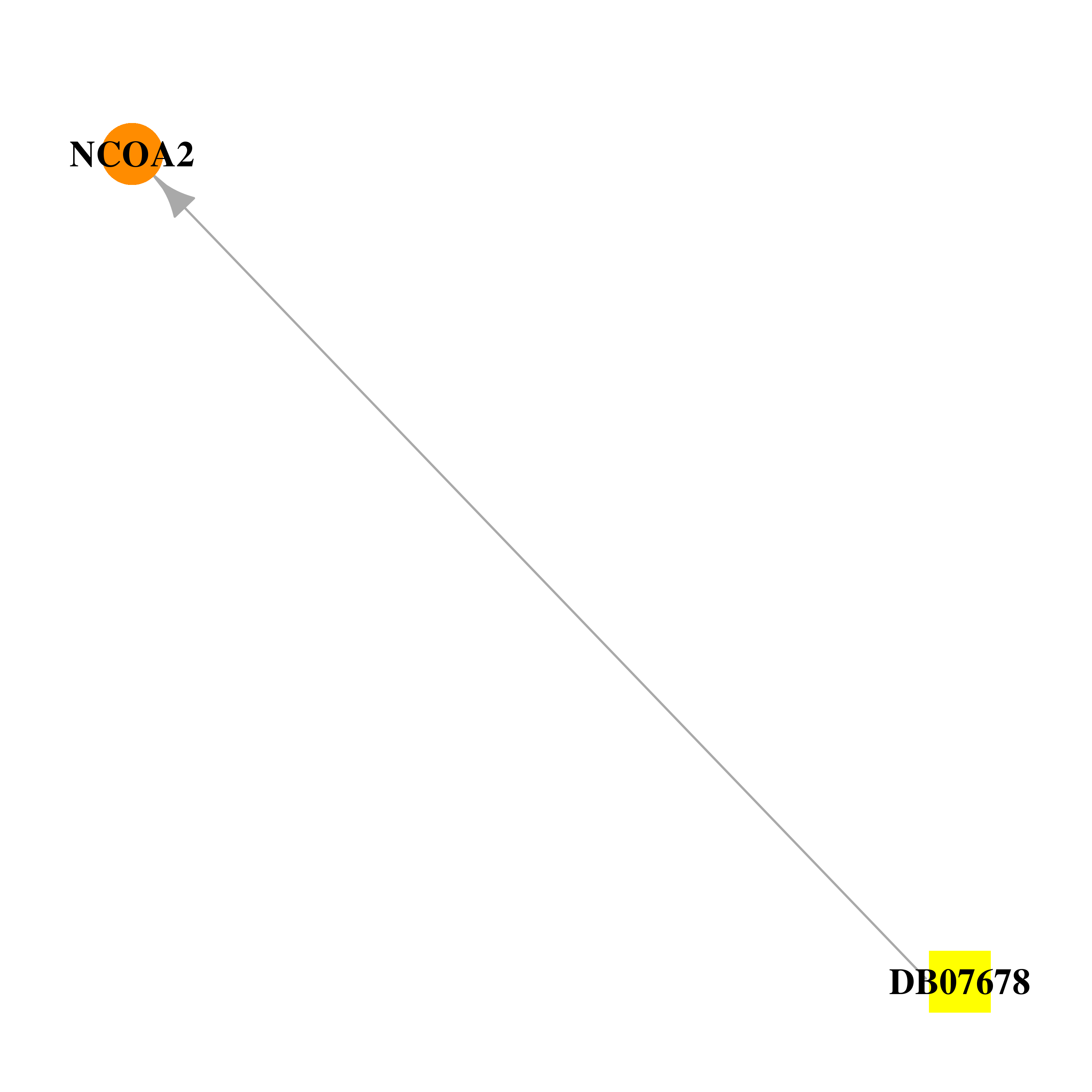 | 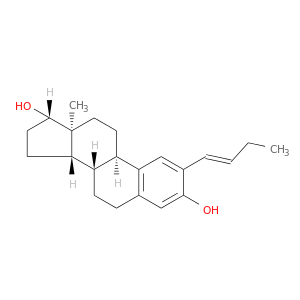 |
| DB07707 | nuclear receptor coactivator 2 | experimental | (9BETA,11ALPHA,13ALPHA,14BETA,17ALPHA)-11-(METHOXYMETHYL)ESTRA-1(10),2,4-TRIENE-3,17-DIOL | 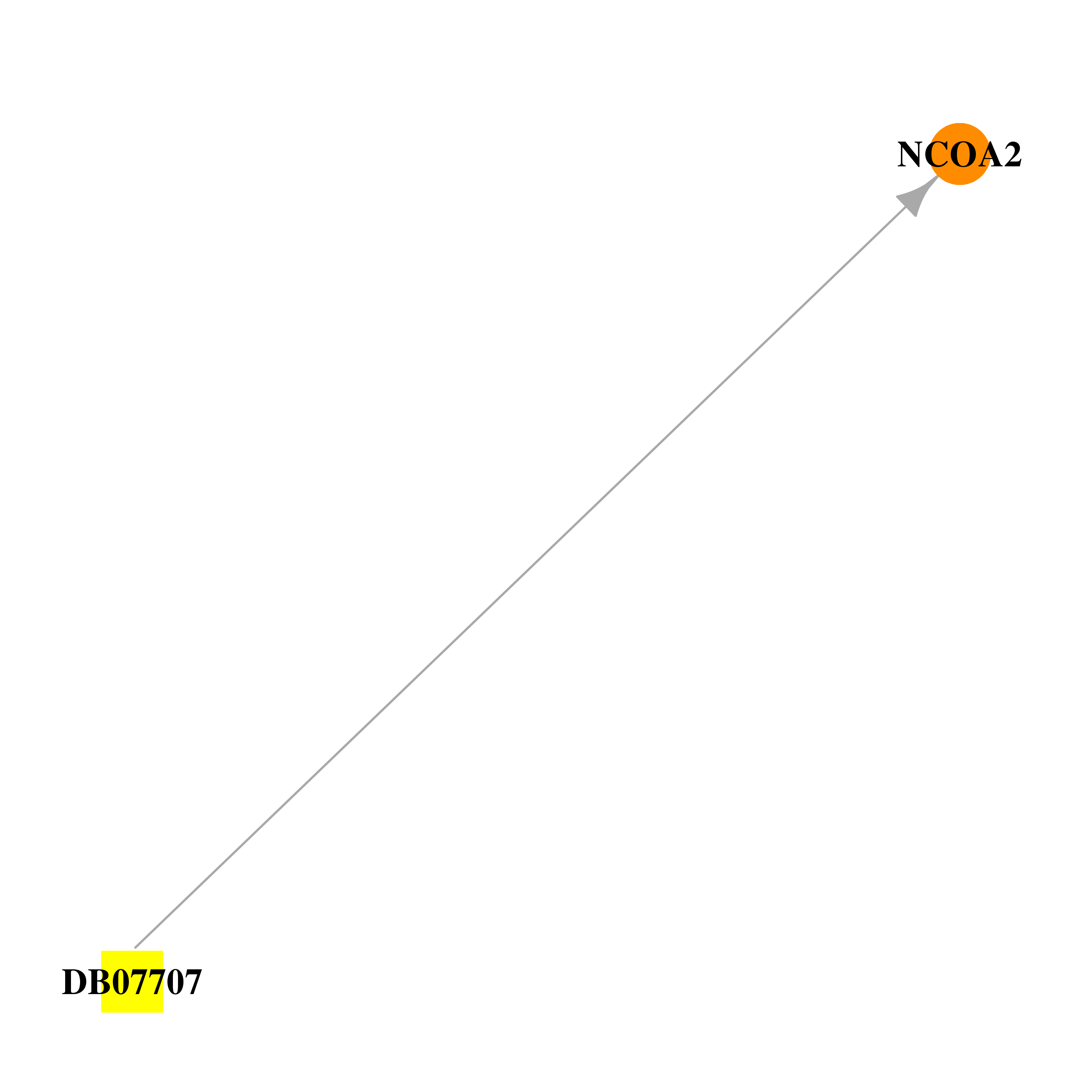 |  |
| DB07708 | nuclear receptor coactivator 2 | experimental | 3-CHLORO-2-(4-HYDROXYPHENYL)-2H-INDAZOL-5-OL | 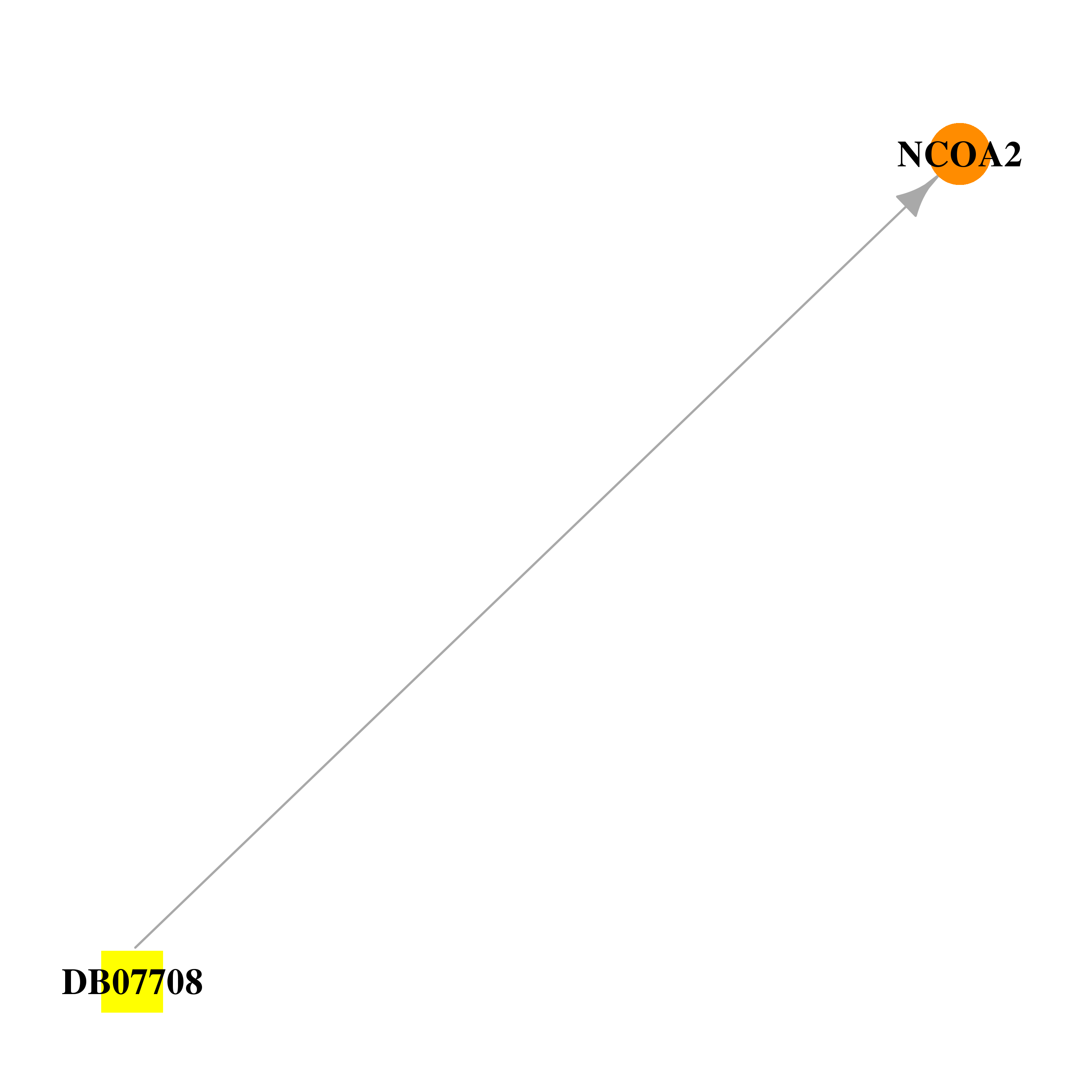 | 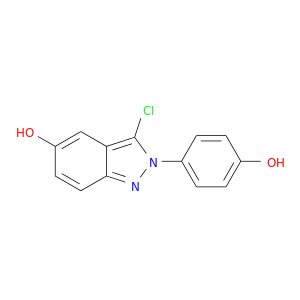 |
| DB07712 | nuclear receptor coactivator 2 | experimental | 3-ETHYL-2-(4-HYDROXYPHENYL)-2H-INDAZOL-5-OL | 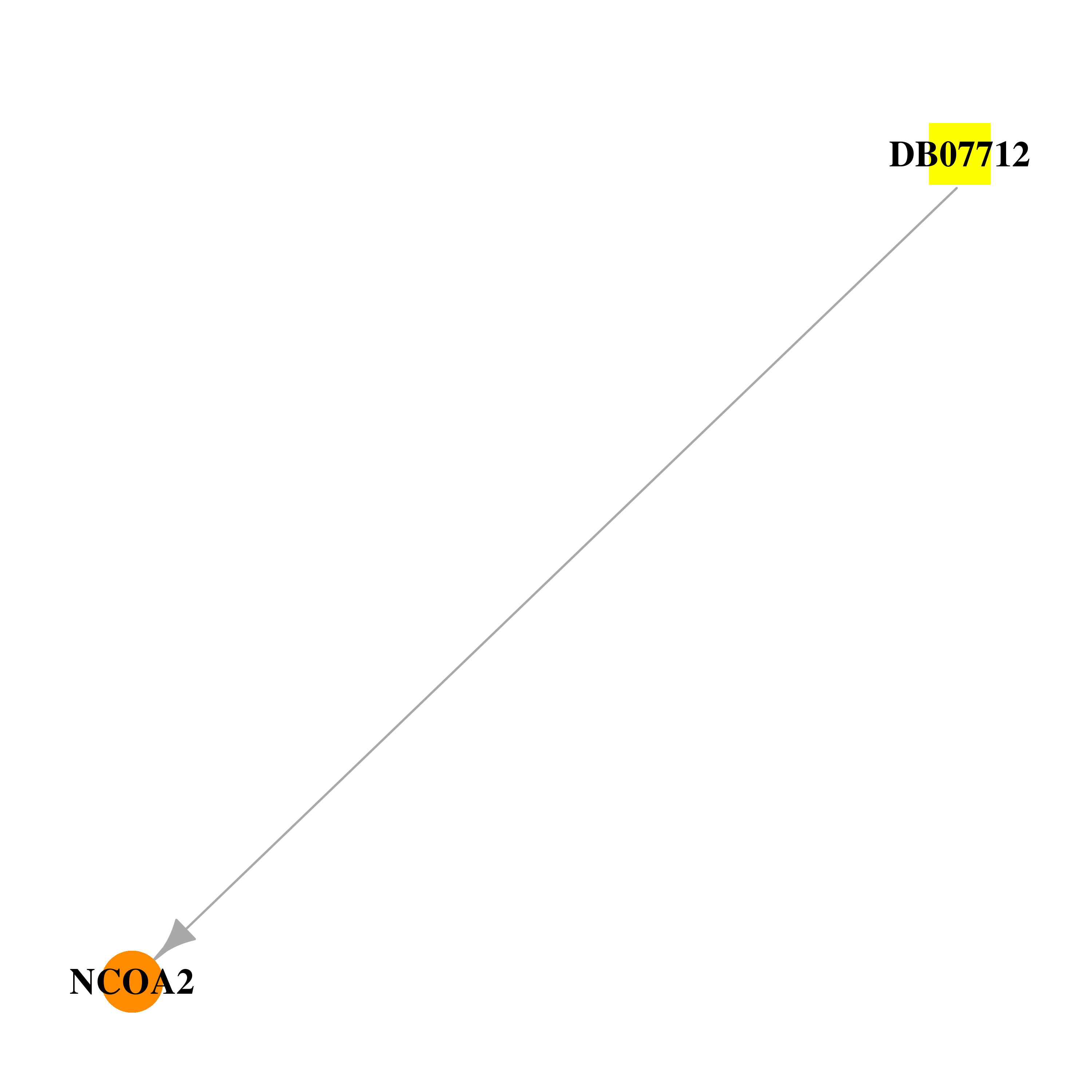 | 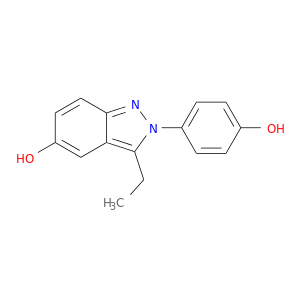 |
| DB07863 | nuclear receptor coactivator 2 | experimental | 2-chloro-5-nitro-N-phenylbenzamide | 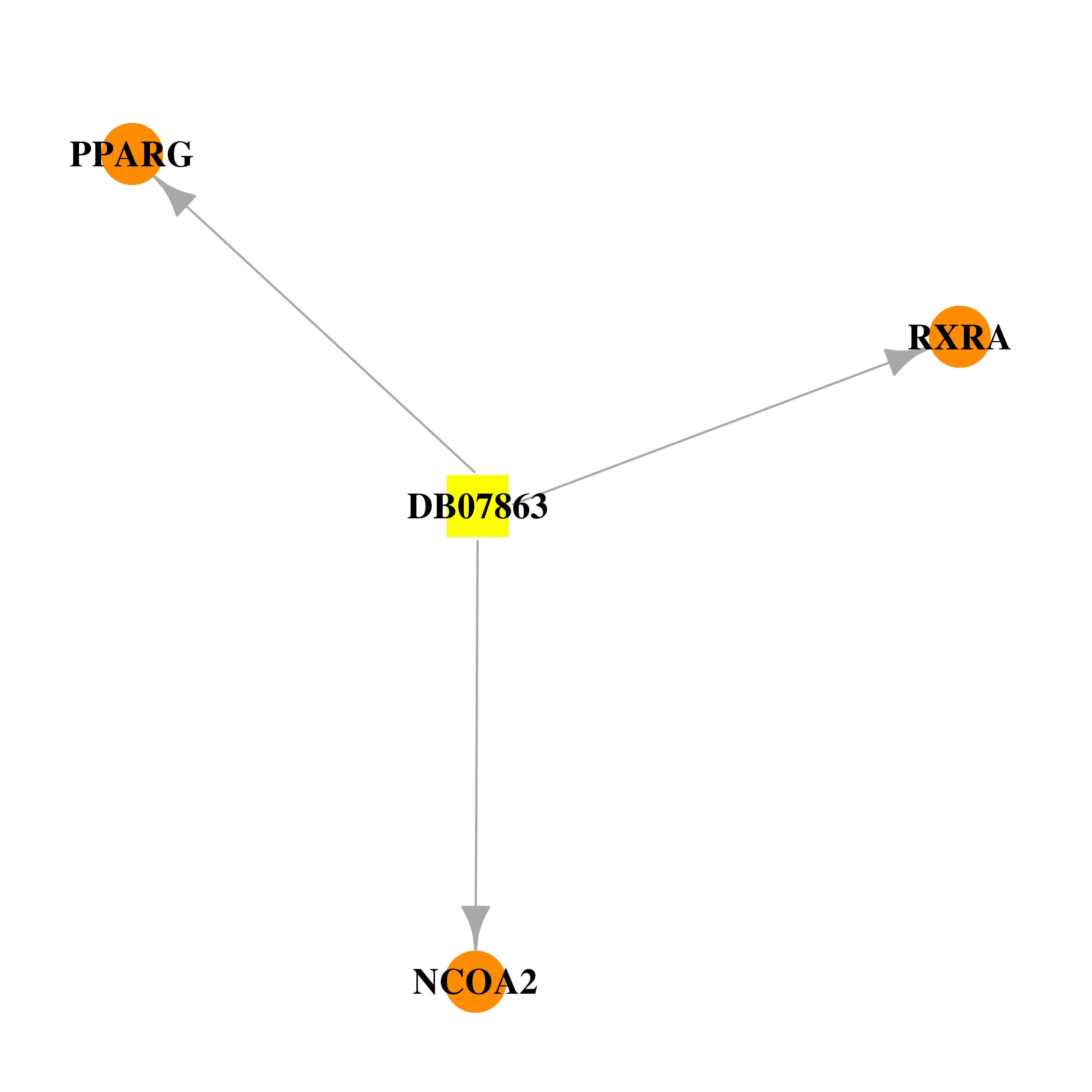 |  |
| DB07932 | nuclear receptor coactivator 2 | experimental | dimethyl (1R,4S)-5,6-bis(4-hydroxyphenyl)-7-oxabicyclo[2.2.1]hepta-2,5-diene-2,3-dicarboxylate | 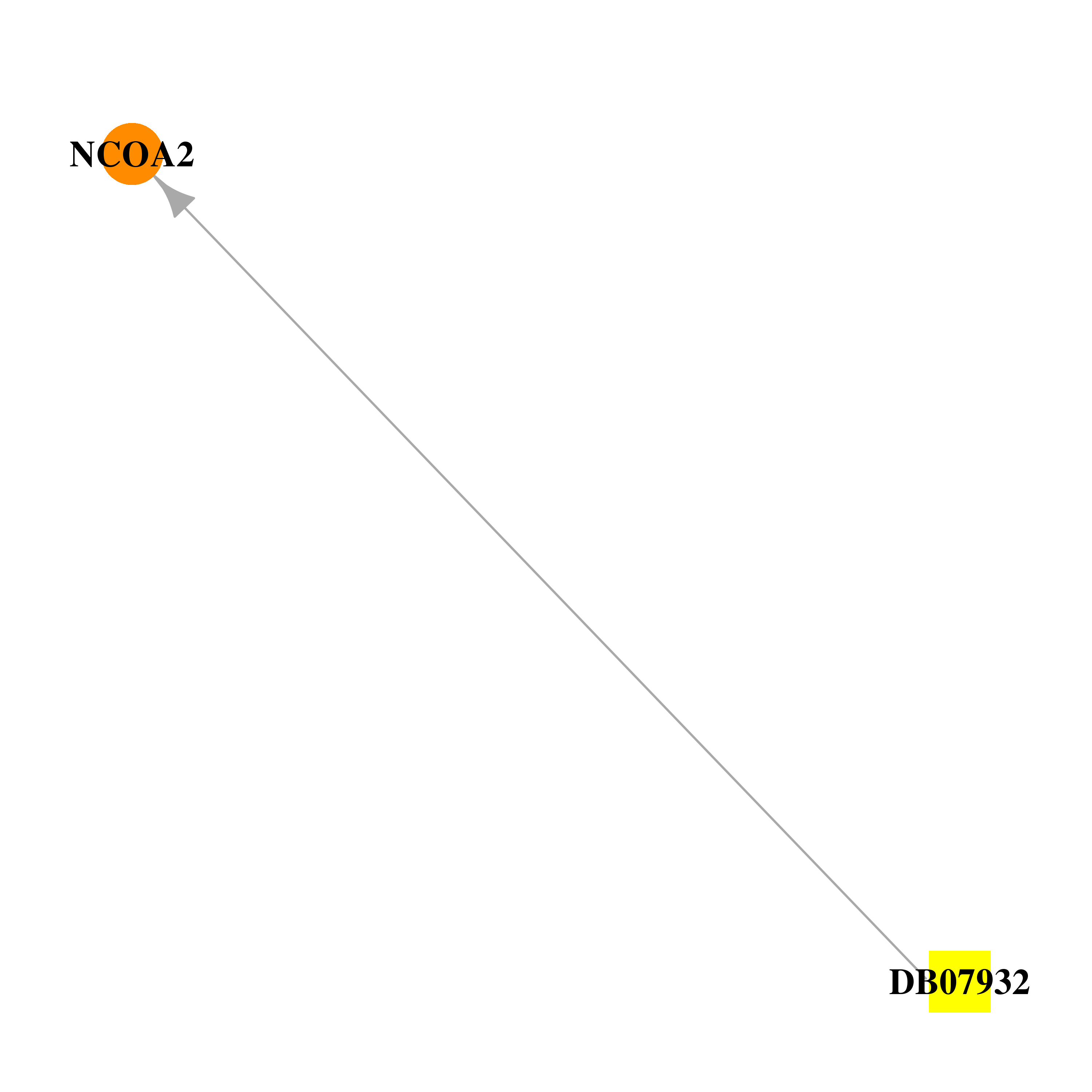 | 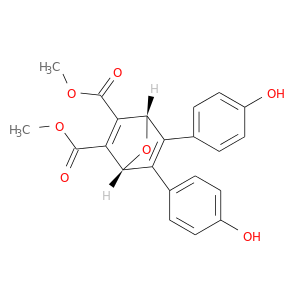 |
| DB08047 | nuclear receptor coactivator 2 | experimental | 4-[1-allyl-7-(trifluoromethyl)-1H-indazol-3-yl]benzene-1,3-diol |  | 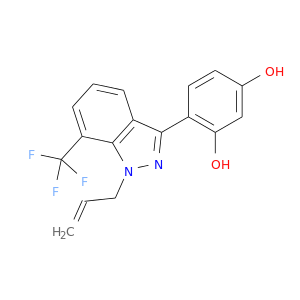 |
| DB08048 | nuclear receptor coactivator 2 | experimental | 4-(6-HYDROXY-1H-INDAZOL-3-YL)BENZENE-1,3-DIOL | 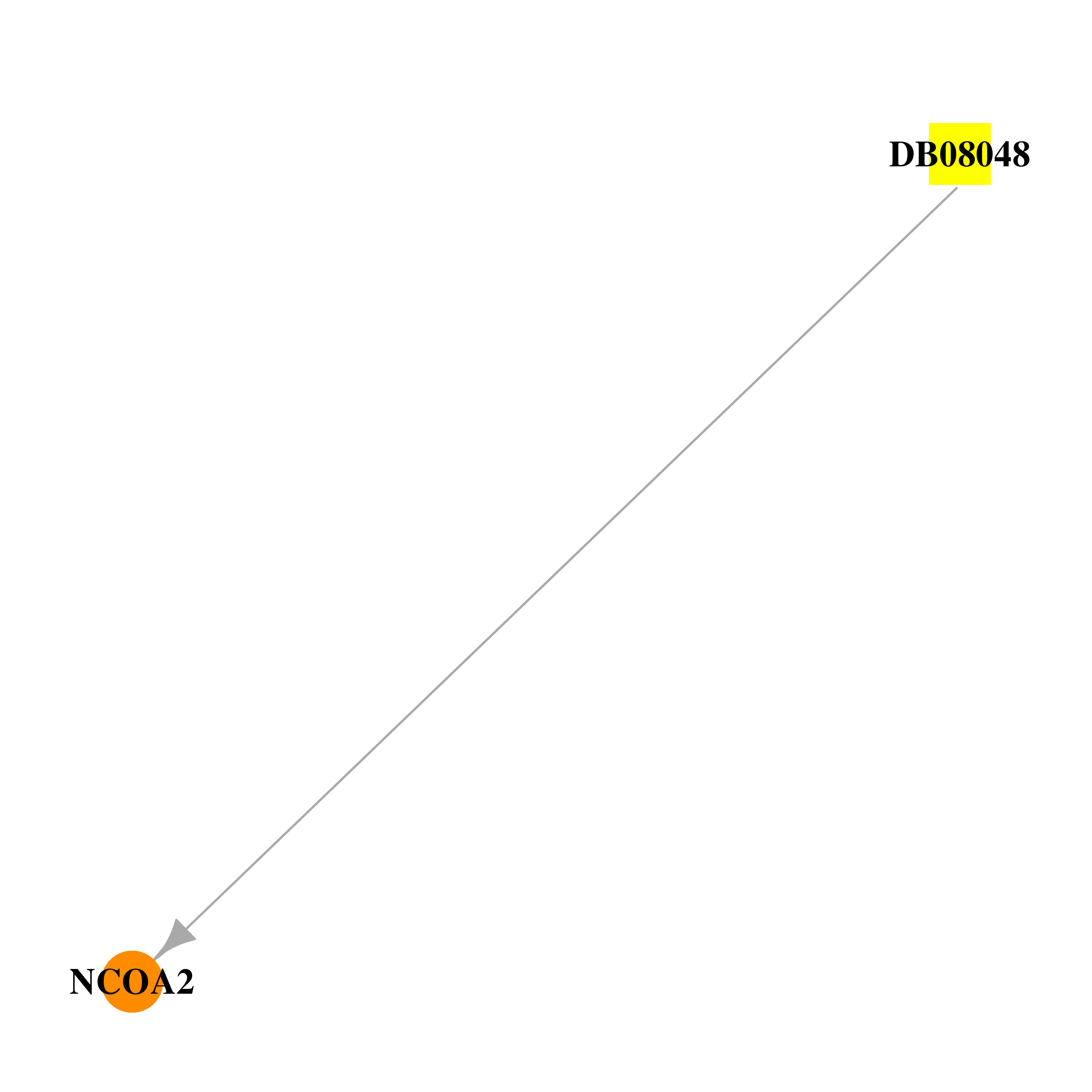 | 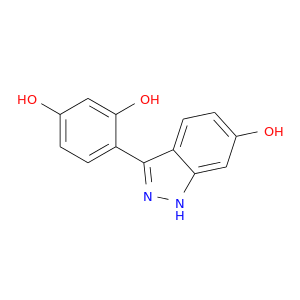 |
| DB08175 | nuclear receptor coactivator 2 | experimental | (2E,4E)-11-METHOXY-3,7,11-TRIMETHYLDODECA-2,4-DIENOIC ACID | 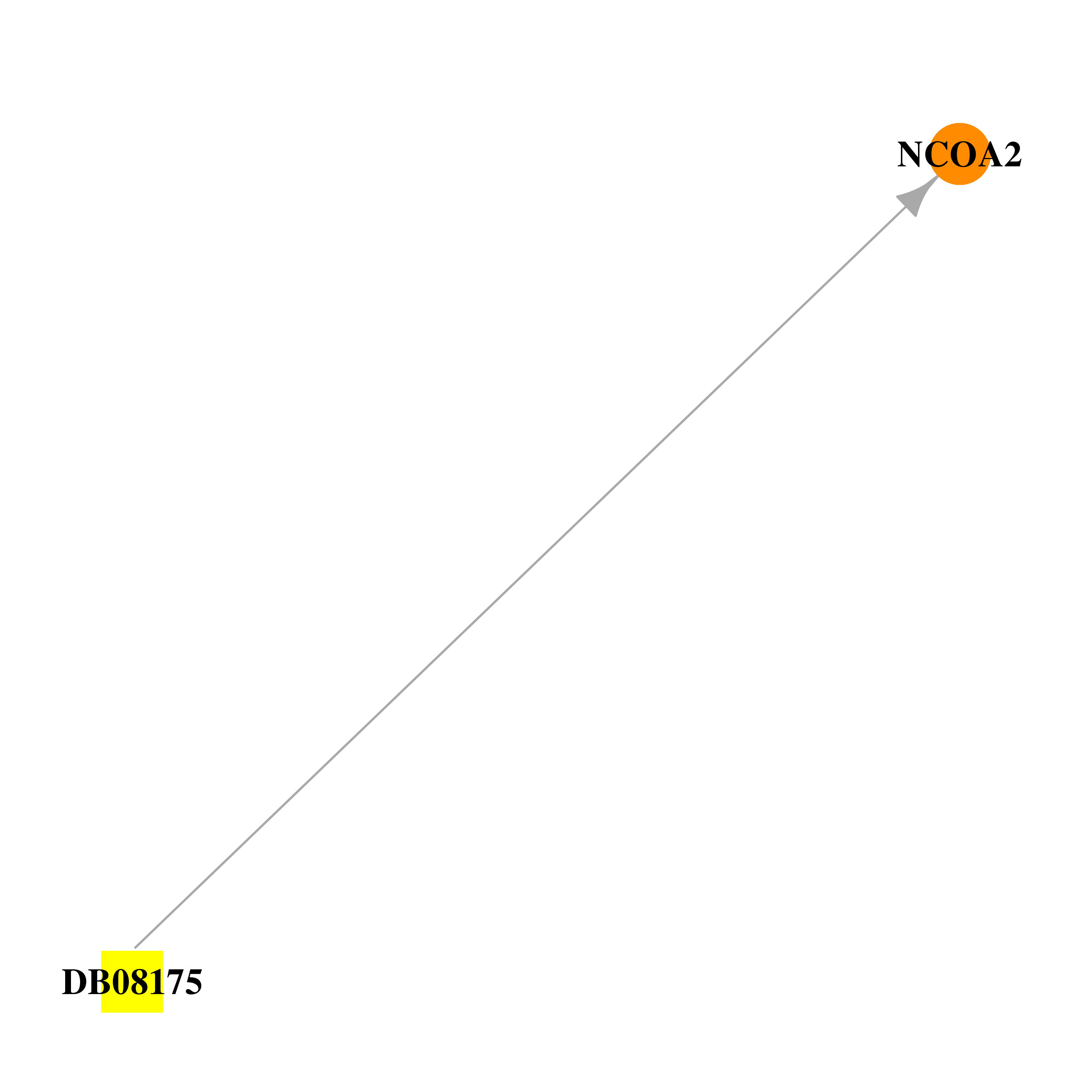 |  |
| DB08320 | nuclear receptor coactivator 2 | experimental | DIETHYL (1R,2S,3R,4S)-5,6-BIS(4-HYDROXYPHENYL)-7-OXABICYCLO[2.2.1]HEPT-5-ENE-2,3-DICARBOXYLATE | 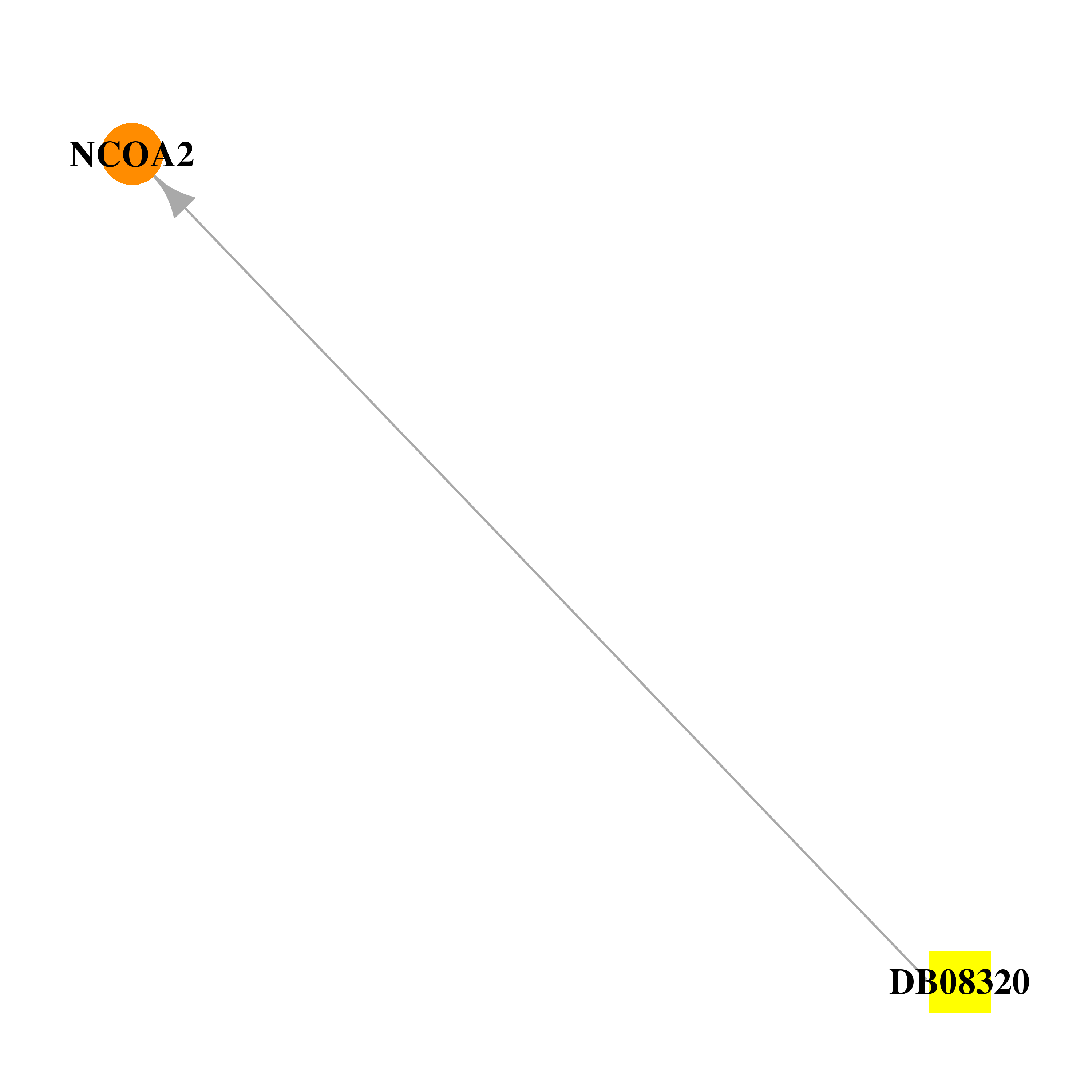 |  |
| DB08398 | nuclear receptor coactivator 2 | experimental | 2-AMINO-1-METHYL-6-PHENYLIMIDAZO[4,5-B]PYRIDINE | 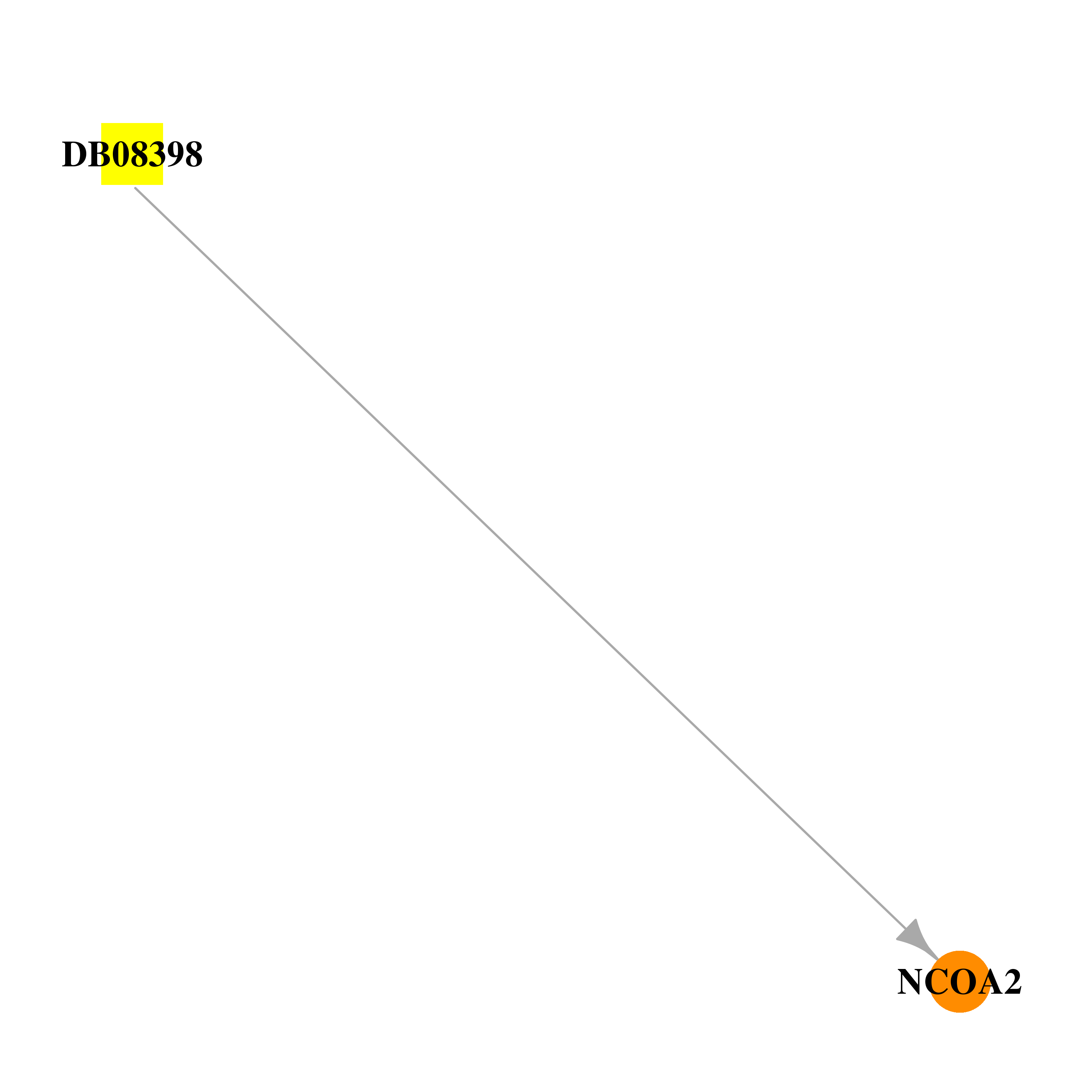 | 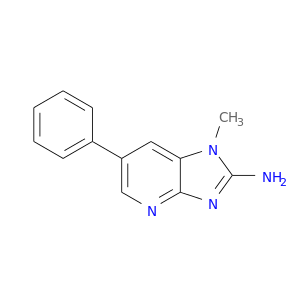 |
| DB08402 | nuclear receptor coactivator 2 | experimental | 2-[(2,4-DICHLOROBENZOYL)AMINO]-5-(PYRIMIDIN-2-YLOXY)BENZOIC ACID | 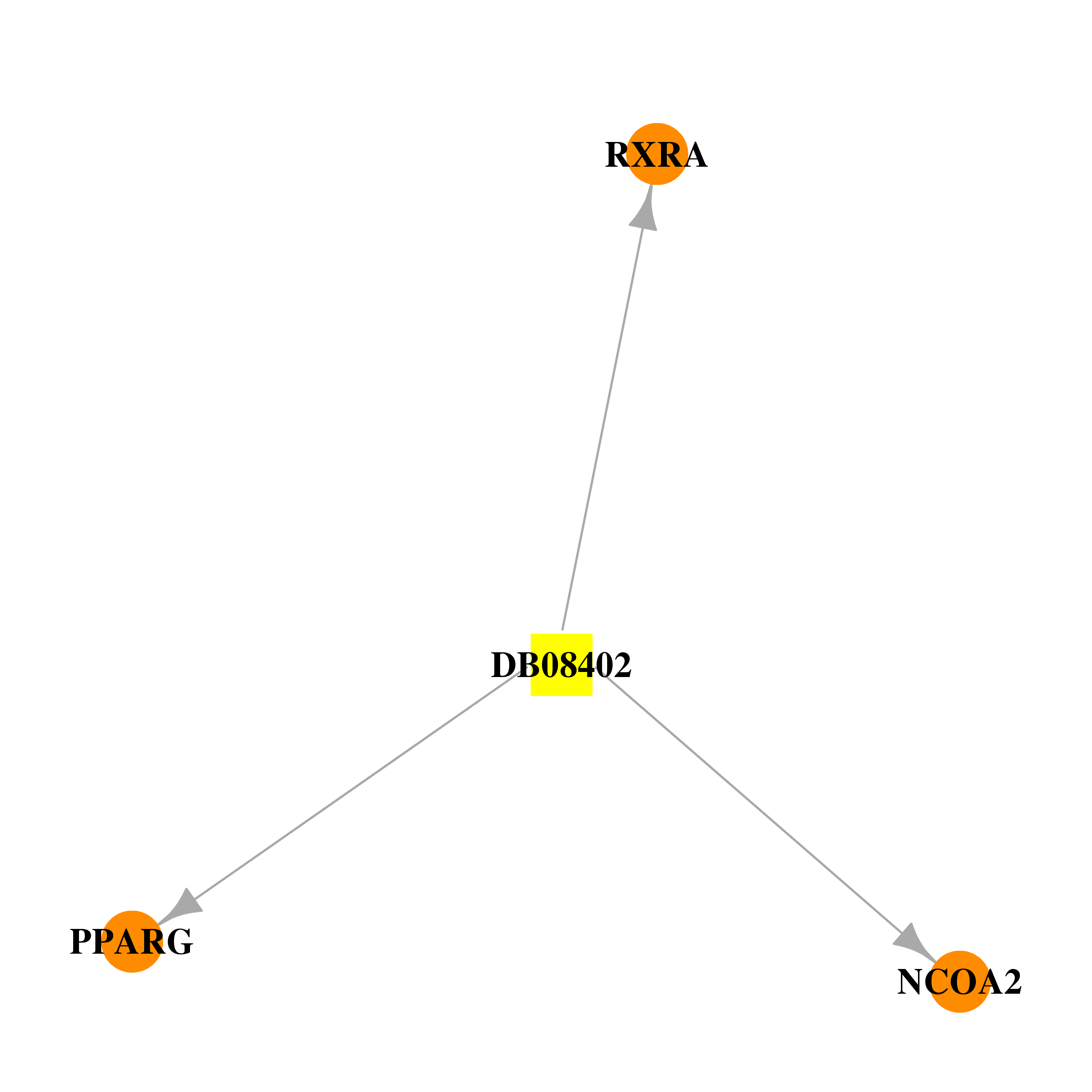 | 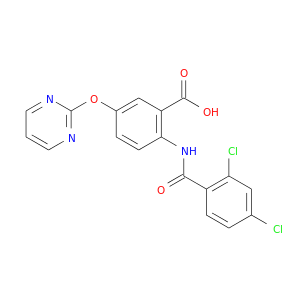 |
| DB08595 | nuclear receptor coactivator 2 | experimental | 4-[(1S,2R,5S)-4,4,8-TRIMETHYL-3-OXABICYCLO[3.3.1]NON-7-EN-2-YL]PHENOL | 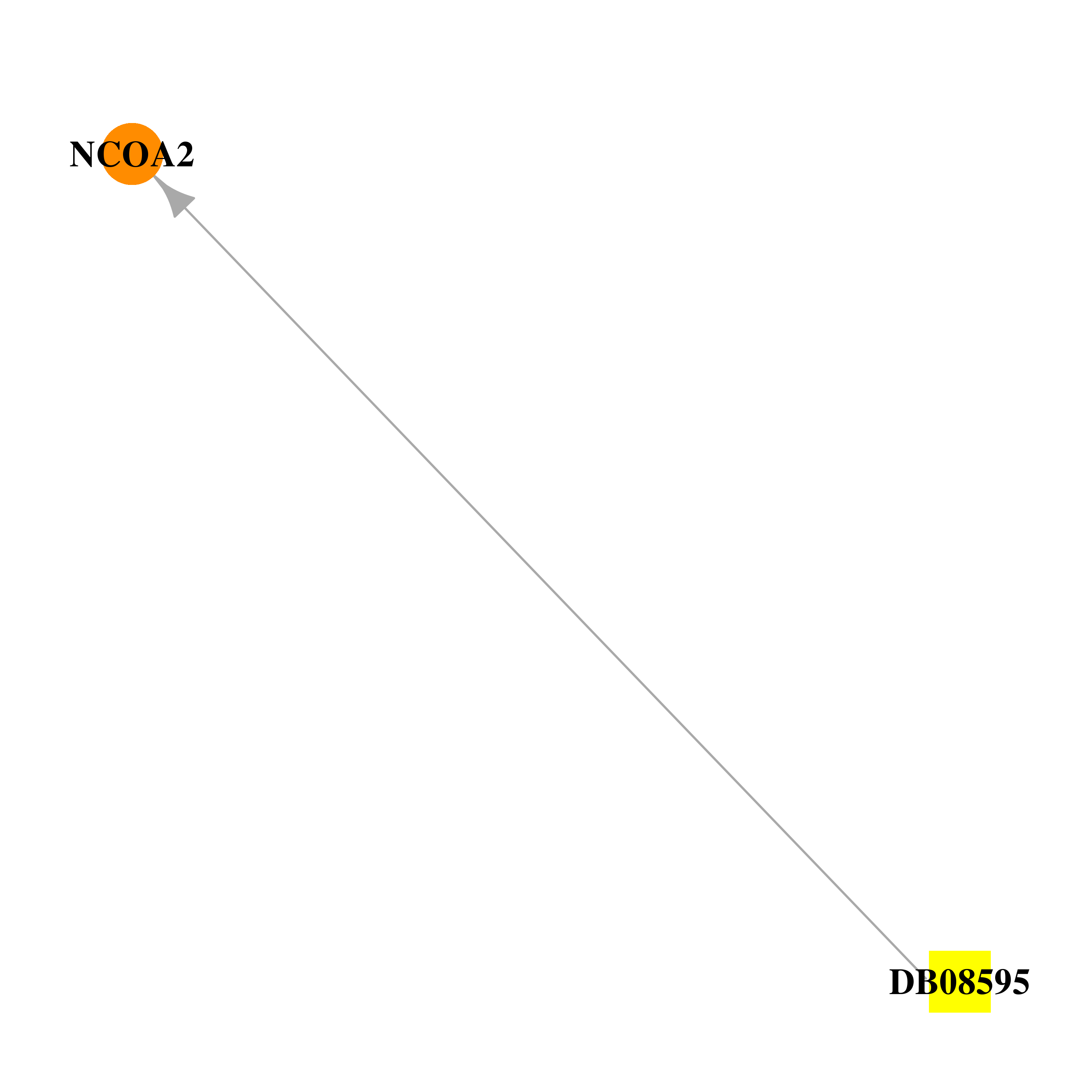 | 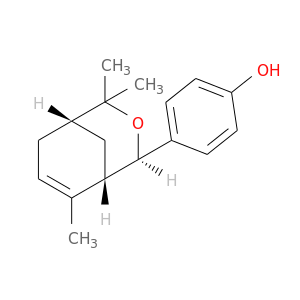 |
| DB08601 | nuclear receptor coactivator 2 | experimental | tributylstannanyl | 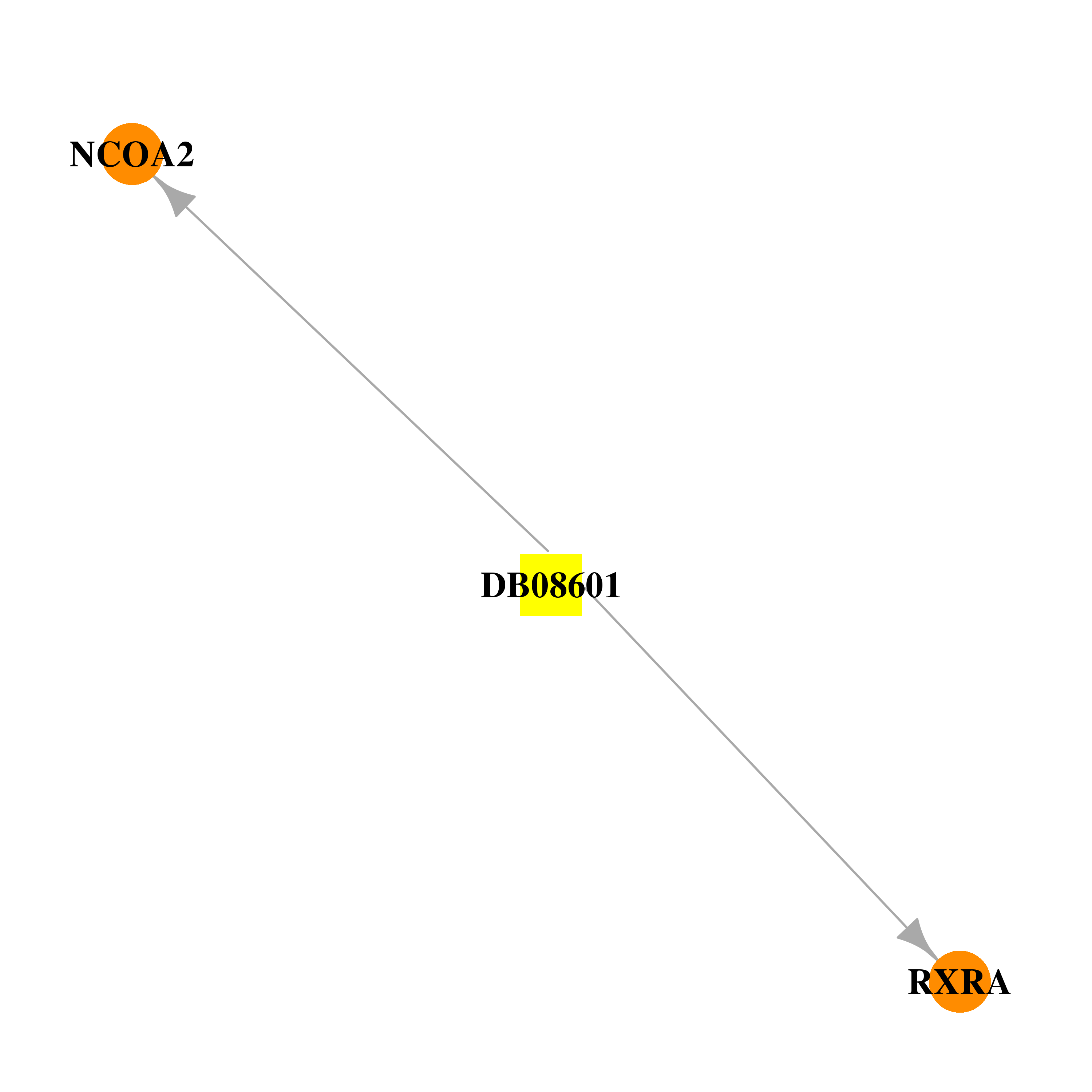 | 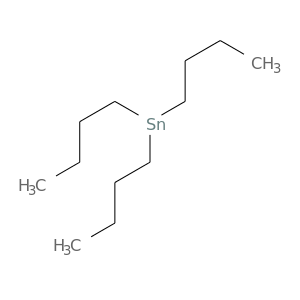 |
| DB08773 | nuclear receptor coactivator 2 | experimental | RALOXIFENE CORE | 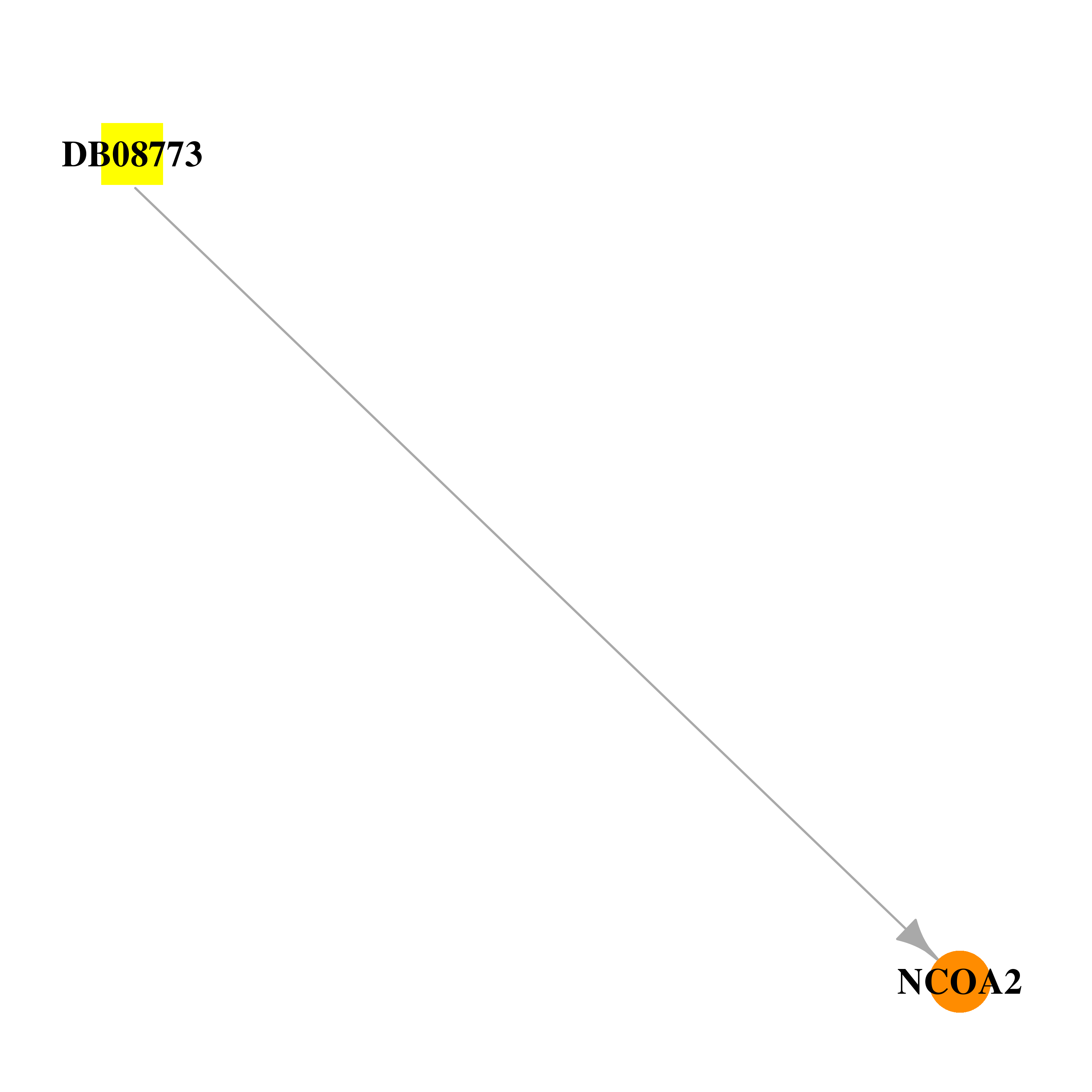 | 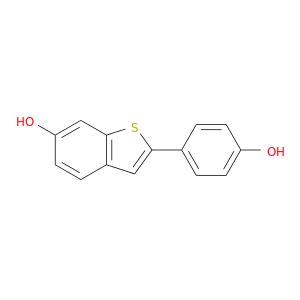 |
| Top |
| Cross referenced IDs for NCOA2 |
| * We obtained these cross-references from Uniprot database. It covers 150 different DBs, 18 categories. http://www.uniprot.org/help/cross_references_section |
: Open all cross reference information
|
Copyright © 2016-Present - The Univsersity of Texas Health Science Center at Houston @ |






